
Have you ever considered the similarities between racing in Formula One and using a CAD software like SOLIDWORKS from both the team’s and driver’s/user’s perspective?
In Formula One, most people are focusing on the Drivers Championship but the more important one is the Constructors Championship, on which basis millions of dollars are distributed to the teams the following year.
Similarly, in an engineering department, the productivity of the whole team is more important than the output of an individual CAD user.
Like the driver from a top team, for maximum efficiency a CAD power user needs the best software, fast hardware specs, professional training and an optimal environment.
| Formula One | CAD |
| Racing Car | SOLIDWORKS |
| Tires | Hardware |
| Pilot | User |
| Garage/Pit | Environment |
It is interesting how many companies are focusing on only one or two of these factors and missing the opportunity to maximize efficiency for the whole team.
Examples of missed efficiencies:
There are multiple articles written on the topics of software, hardware and training. This article will focus on one important aspect of the CAD environment: System Settings.
SOLIDWORKS was built on the principle that users will tell how the software should work—not the other way around. As a result, with over 6 million users of the software, the options for customizing one’s environment accommodates for the differences in needs, modeling techniques and hardware systems that exist in the SOLIDWORKS community. As usage needs shift from individual users to teams and companies, consistency in SOLIDWORKS settings and modeling techniques becomes more important than the personal preferences of each user.

Figure 1: Speed or consistency? How about both?
System Options in SOLIDWORKS can be accessed from multiple locations in the interface. Most users prefer the convenience of a single-click access using the gear-like icon on the standard toolbar.
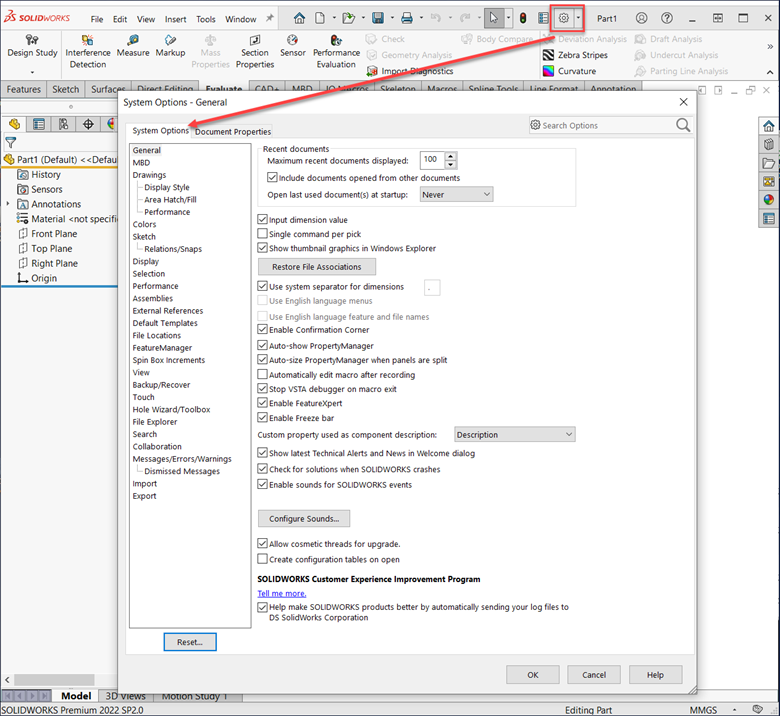
Figure 2: System Options access icon.
If a document has already been opened, the dialog box has two tabs:
It is worth noting that depending on the SOLIDWORKS version you have installed, you might find certain settings under System Options in one version and under Document Properties in another.
Example: The setting for saving Detailing mode data for drawings is a system option in SOLIDWORKS 2020 and 2021 and a Document Property in SOLIDWORKS 2022 or newer.
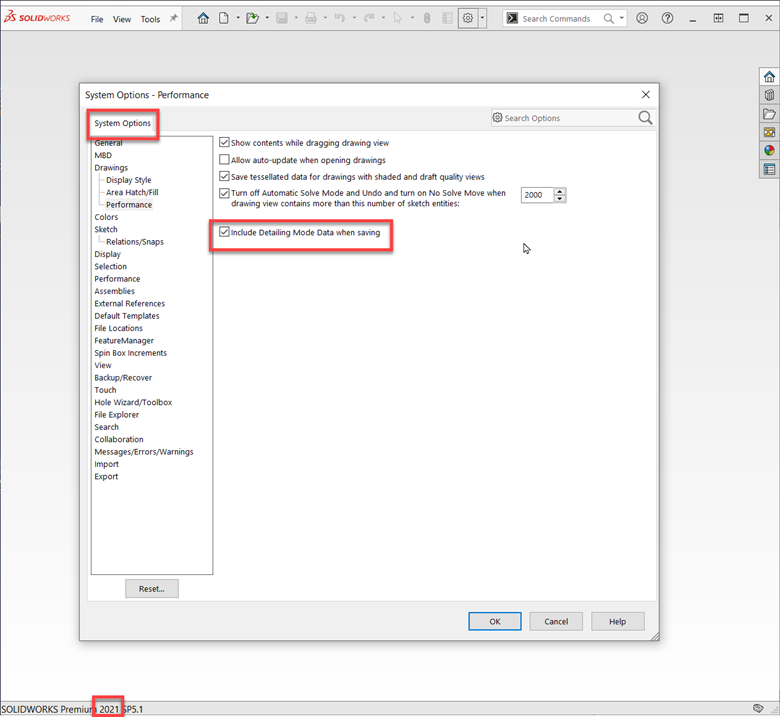
Figure 3. Detailing Mode Data as a System Option in SOLIDWORKS 2021.
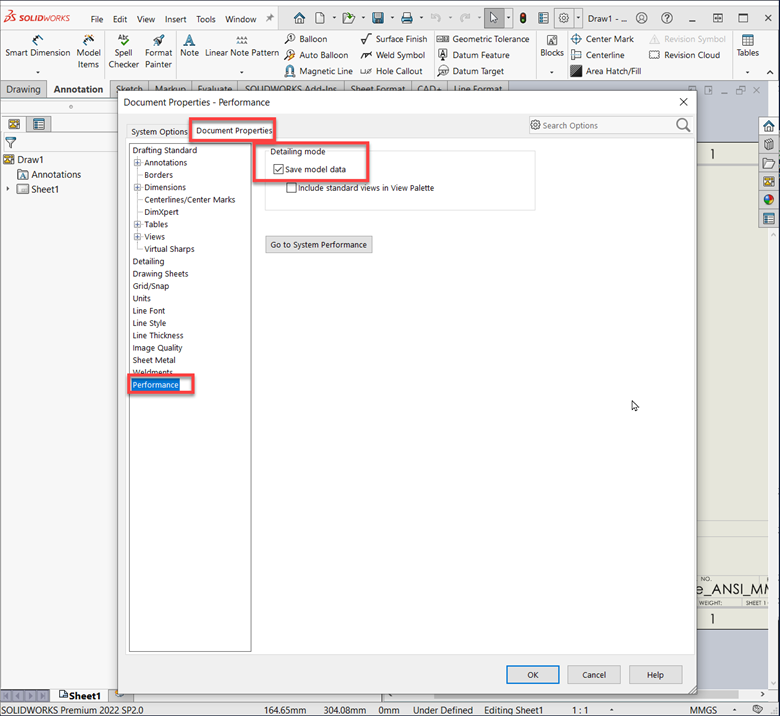
Figure 4. Detailing Mode Data as a Document Property in SOLIDWORKS 2022.
Browsing to find a specific system option is a daunting task because there is no apparent logic for the order the options are listed in. As SOLIDWORKS evolved over the years, new options were added in various places with little care for the user experience.
As a result, new users could get lost trying to find a specific option by browsing.
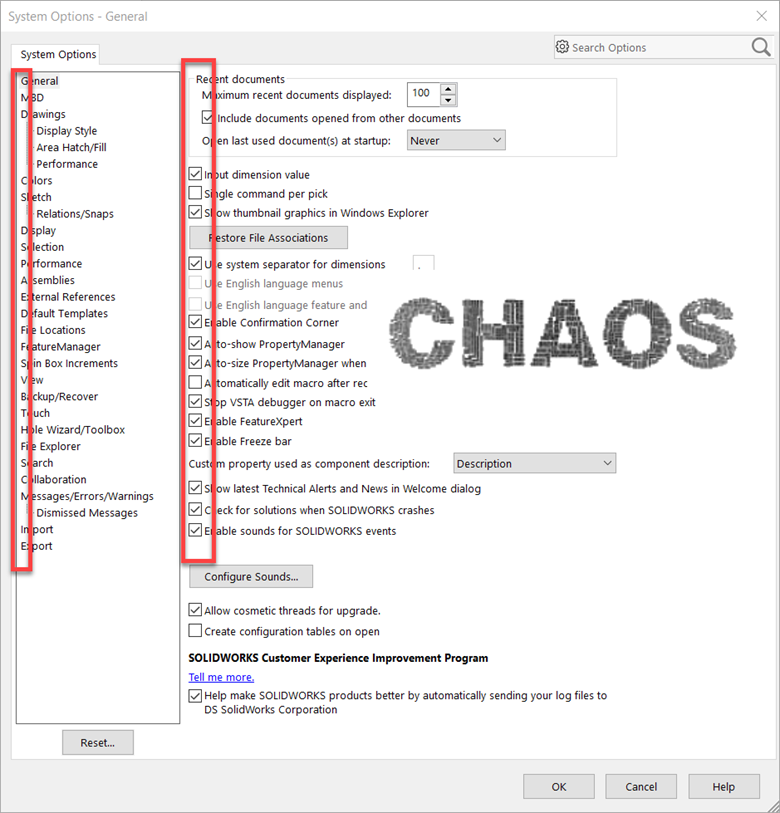
Figure 5. A chaotic set of options, almost impossible to browse.
Fortunately, since 2013, the developers added the Search Options field, making finding any option a breeze (Figure 6).
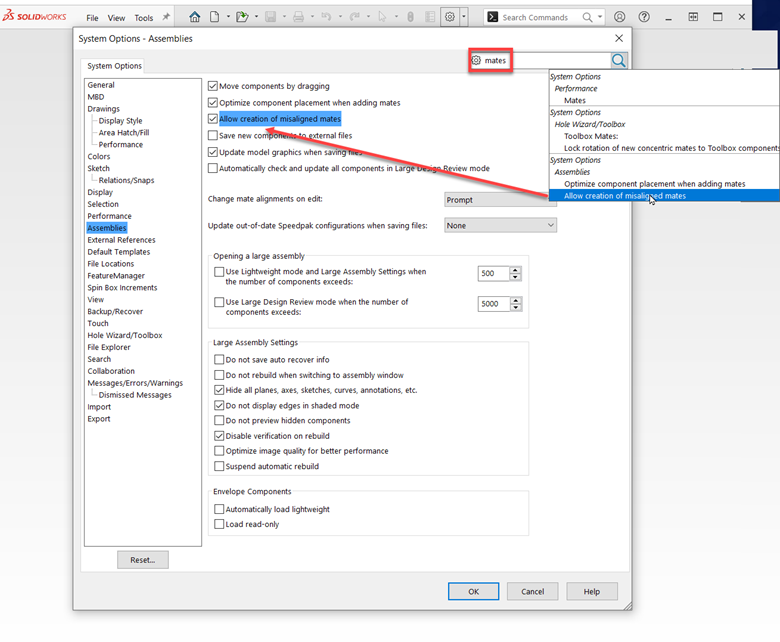
Figure 6. Why browse when you can search?
With such a large number of options to customize, professional CAD administrators need to examine the way their team uses SOLIDWORKS in depth in order to find the optimal set of settings that maximizes productivity while minimizing possible errors.
For a user, working with optimal system settings is akin to driving a Formula One car that has been tuned for a specific course and specific weather. Not having to worry about what could go wrong with the car allows the user to focus only on driving their CAD program the most efficient way.
Users who design parts with complex shapes would benefit from a different set of system settings than the mold designer or users of large assemblies and drawings.
For example, students in TriMech’s Large Assembly and Drawing workshop receive a reference document describing in detail a set of settings focused on optimization for:
• Minimizing opening times for large assemblies and drawings.
• Minimizing operational slowdowns after the model or drawing has been opened, caused by:
• Maximizing operational efficiency, by:
• Reducing clutter on the Graphics area and the Feature tree.
• Maximizing operational security.
• Ensuring modeling consistency.
This article will focus on a selection of 20 system settings that are critical for one or more of these factors:
This setting is probably to biggest slow-down factor for users of complex parts or large assemblies that is independent of the user experience with using SOLIDWORKS.
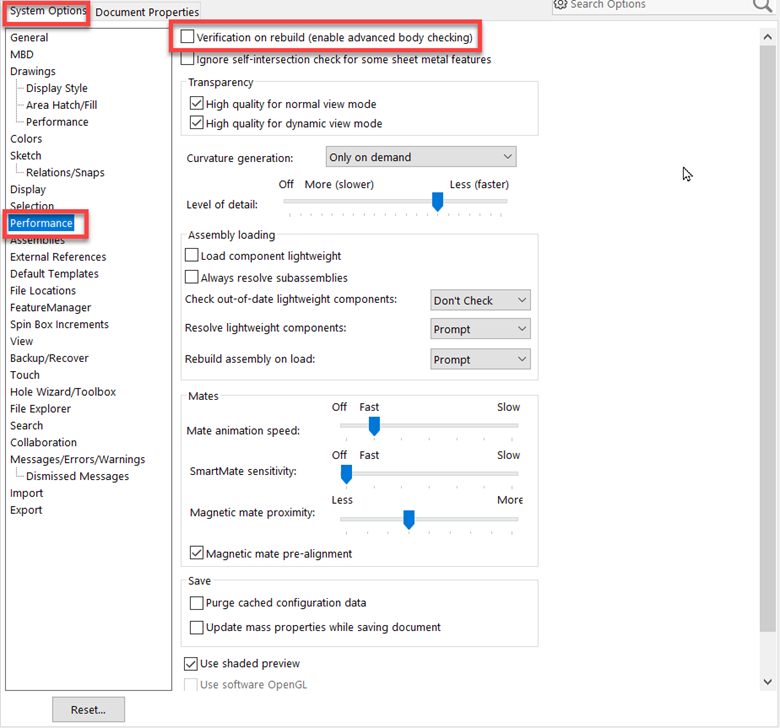
Figure 7. Uncheck for “Turbo” mode, check for “Safe” mode.
To understand the effect of this setting, it is worth remembering the importance of having solid and surface bodies with clean topology in your models. One of the typical factors that would invalidate a body in SOLIDWORKS is the intersection of its faces without generating an edge along the intersection curve. A typical error is that “a face is piercing trough the solid” when running the Import Diagnostics tool (see Figure 14 in the Import Diagnostic Tool—The Ultimate Guide article).
Imagine how much work the software needs to perform for validating every feature that adds or modifies faces. Ideally, any new or modified face should be checked for invalid piercing against all the faces of the model regardless of a common edge with the new face.
That is the effect of checking the “Verification on rebuild” setting. All faces will be involved in this validation process. Should the software spot a piercing condition, an error tag will appear on the feature that generated the invalid faces.
To save time, this setting can be unchecked. In this case, only the faces who share edges or vertices with the new faces will be checked during the rebuild process. The chances of such errors appearing are minuscule, but it is important for the user to be aware of how to spot them before more work is being performed on a flawed body.
To demonstrate this functionality, follow these steps:
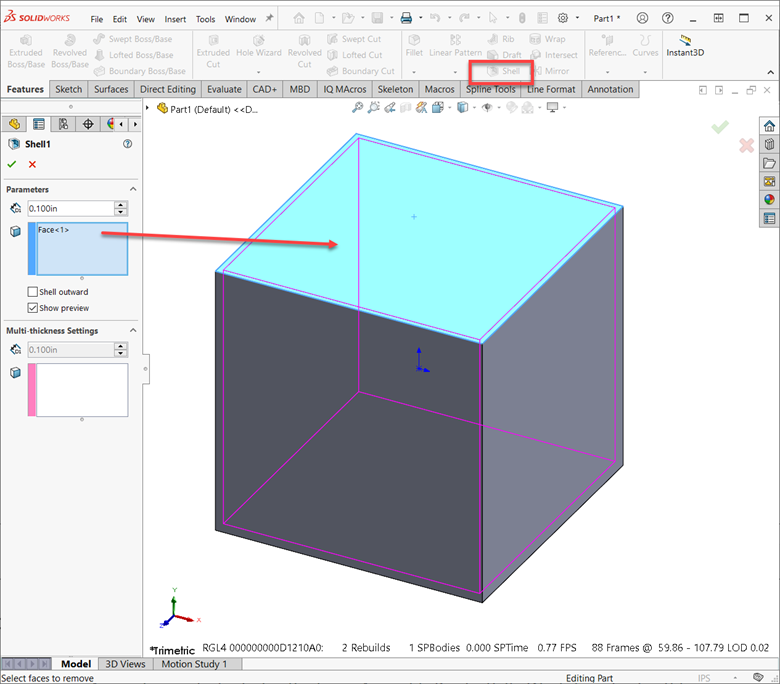
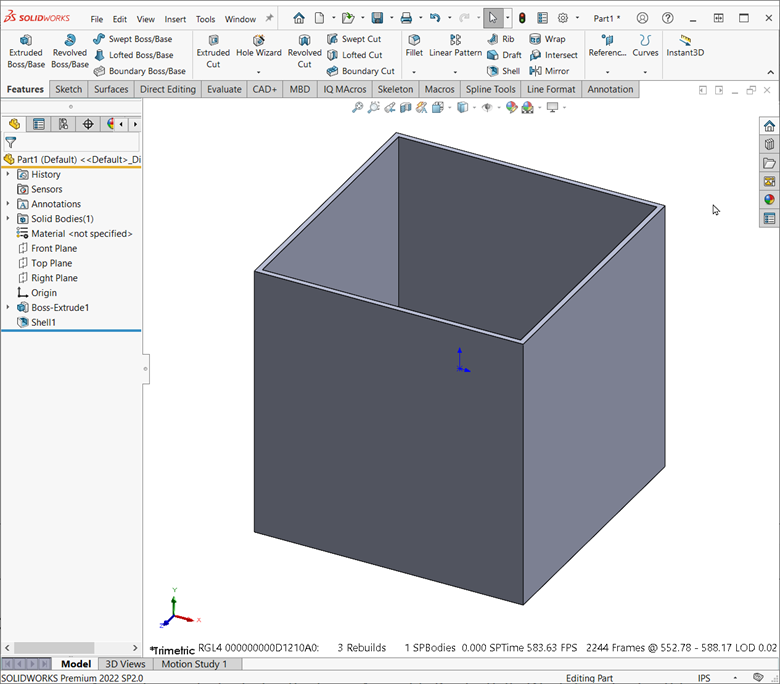
Figure 9. Y-Axis is up.
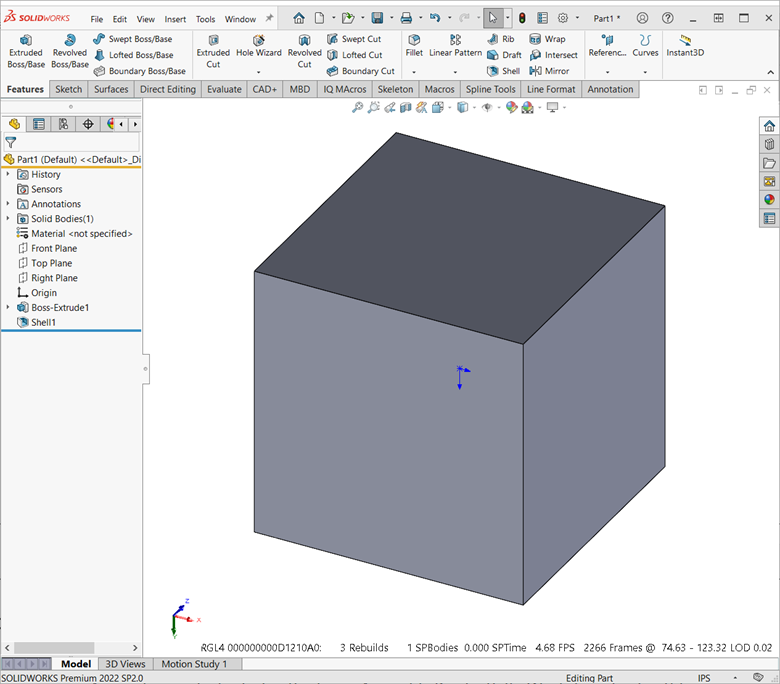
Figure 10. Y-Axis is down.
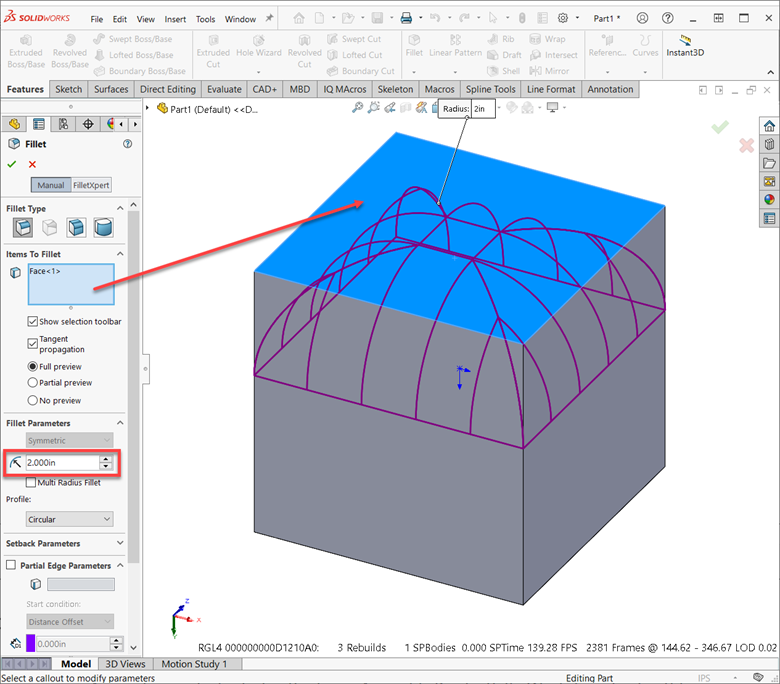
The result is an invalid solid body. The faces created by the Fillet features are piercing through the inner faces of the Shell. Notice that there is no error displayed in the FeatureManager tree.
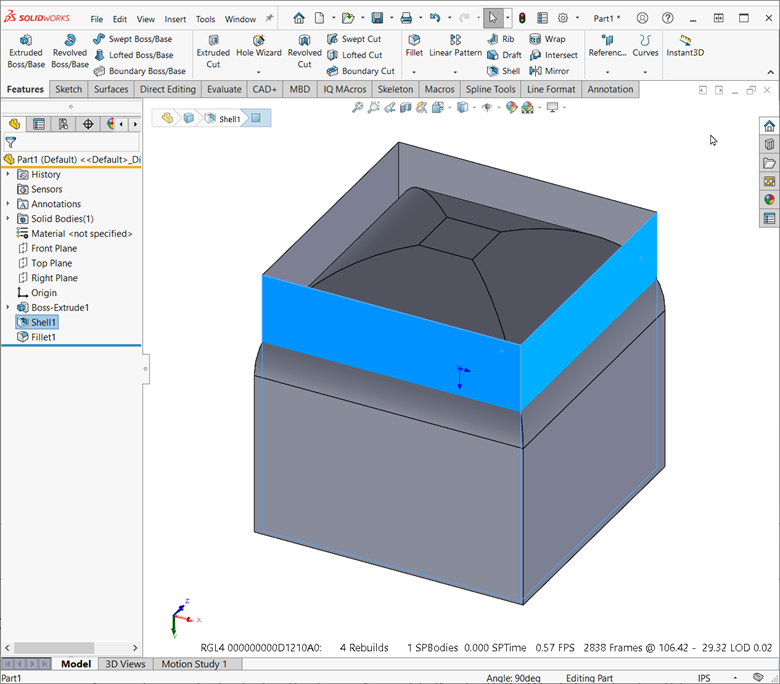
Figure 12. Faces piercing other faces and there is no error.
While such situations are very rare in practice, it is important for users to be trained to run the Check tool before a part is saved. This way the chances of the design progressing a lot on a flawed model are reduced.
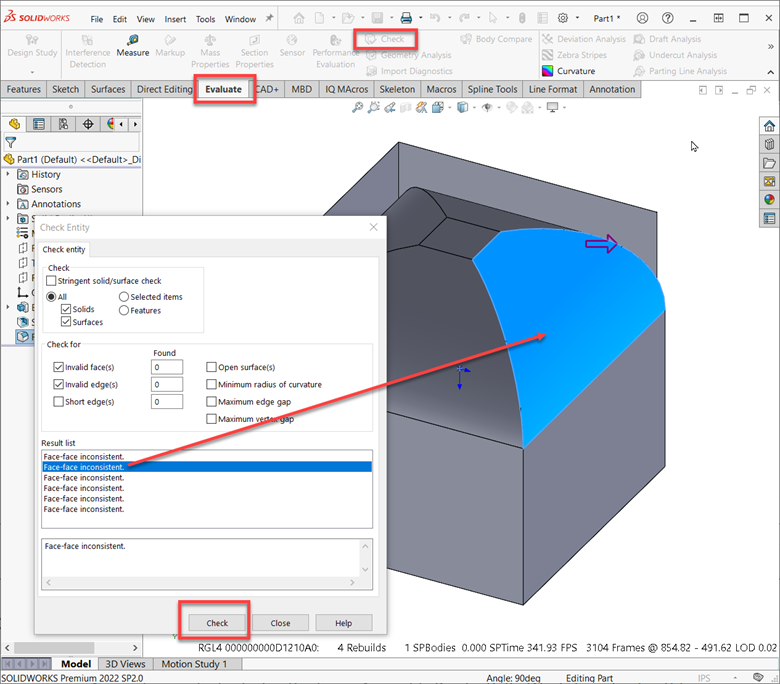
Let’s see what happens when the “Verification on rebuild” is checked.
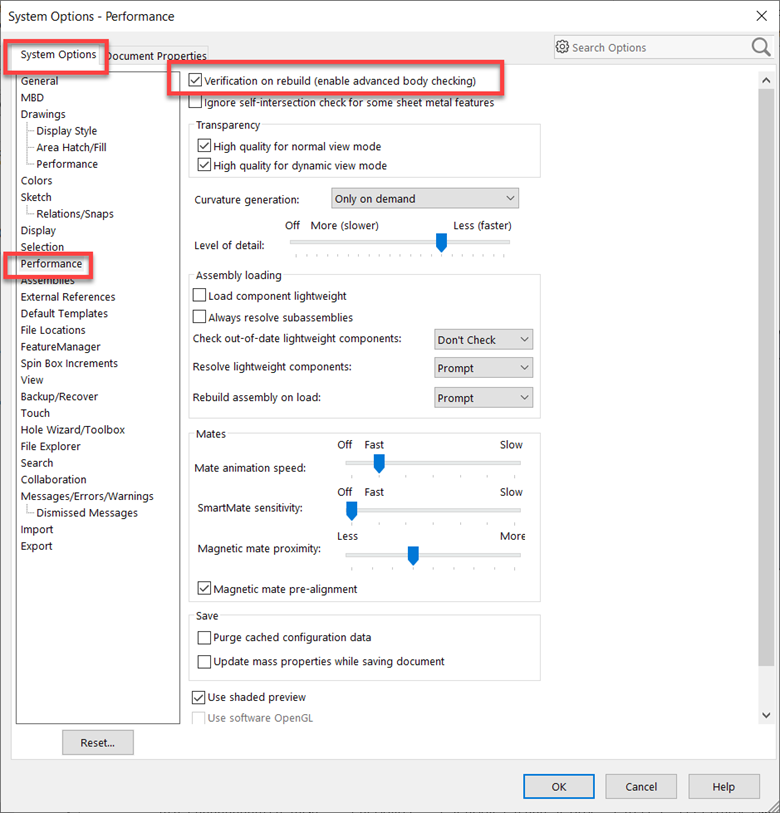
Note that the Fillet1 feature has an error and the model does not create the invalid faces.
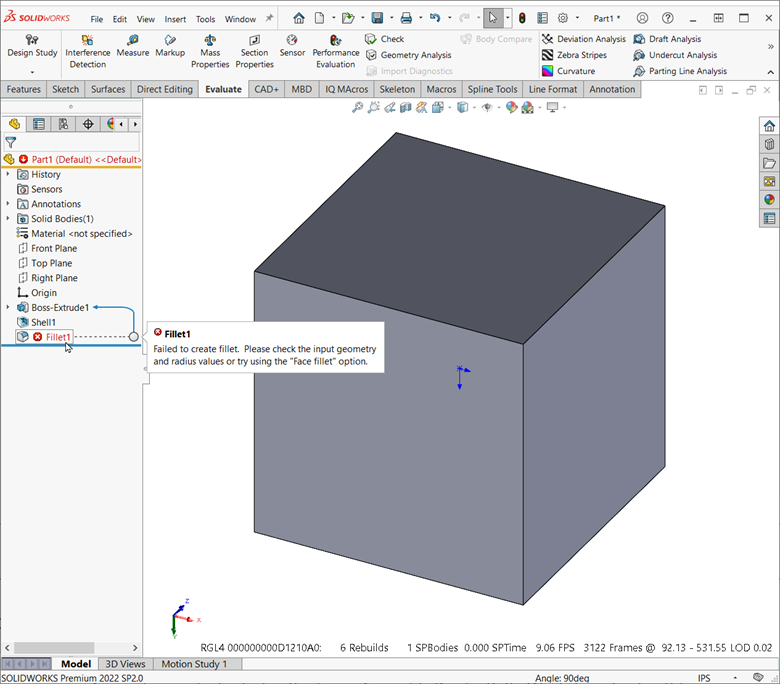
You might wonder why there is even an option for turning off “Verification on rebuild.” To understand its impact on performance, let’s consider a model with only two features but with many faces.
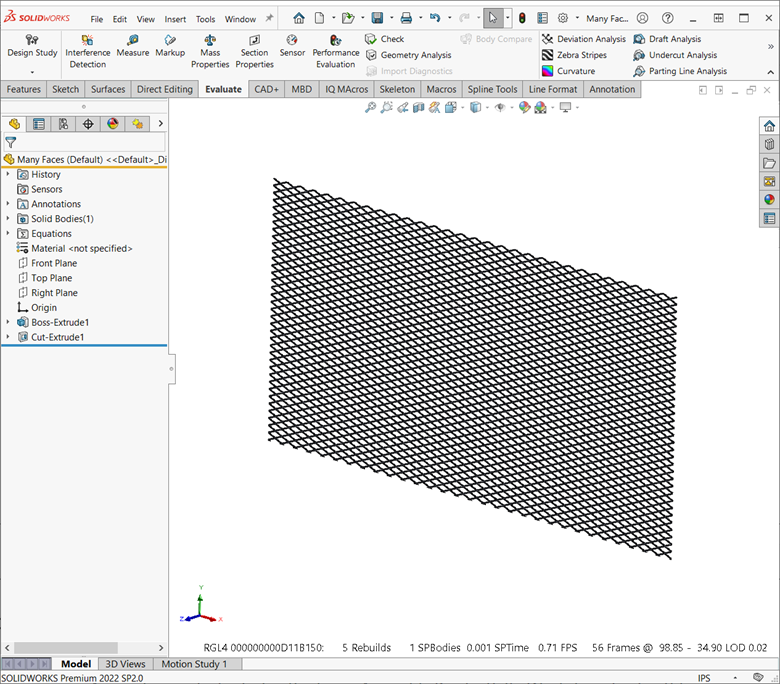
Figure 16. Only two features.
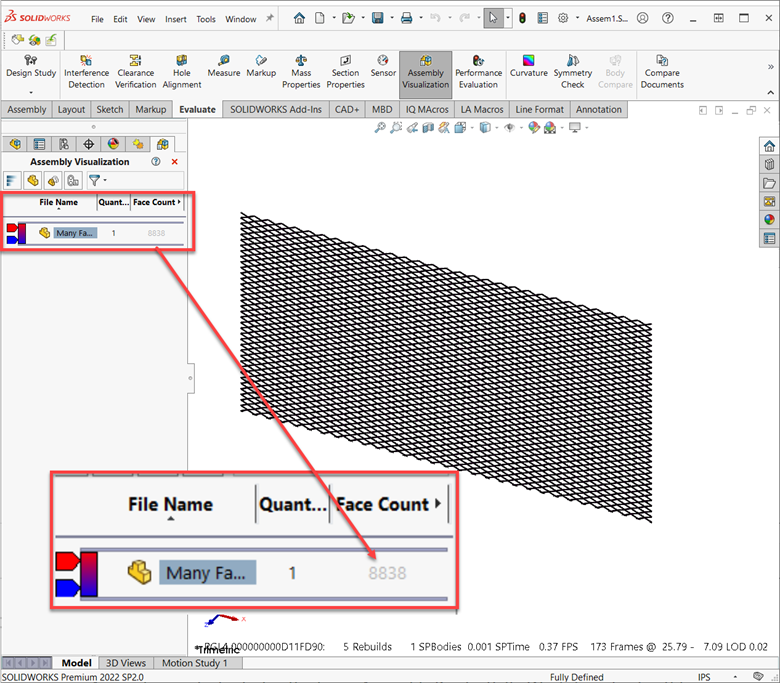
Figure 17. 8838 faces!
We will force-rebuild the part with “Verification on rebuild” checked and unchecked.
The rebuild times are measured by the Performance Evaluation tool and displayed in Figures 18 and 19.
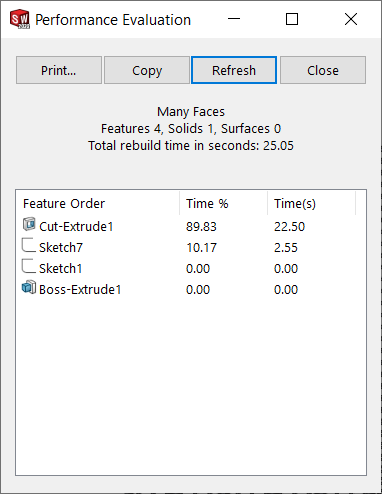
Figure 18. Verification on rebuild unchecked.
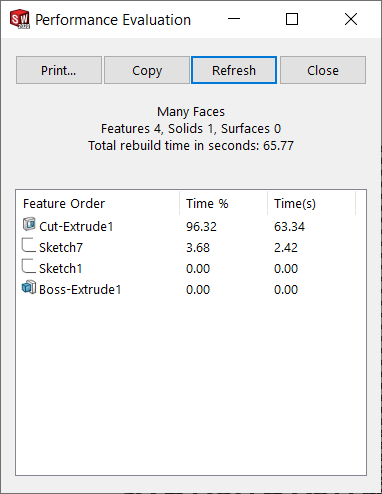
Figure 19. Verification on rebuild checked.
The results clearly show how much longer the cuts, which generate all those faces, take when the thorough validation process is performed.
| Verification on rebuild | Rebuild time (seconds) |
| Unchecked | 22.50 |
| Checked | 63.34 |
| Slow down factor | 2.82 |
In this case, the model is processed three times faster with the setting unchecked. The slow-down factor grows exponentially with the number of faces so the impact on performance could be significant.
While this setting controls the checks that are performed during the rebuilding of parts, it could also drastically impact assembly performance if one or more of the following conditions are present:
To mitigate these issues, when using Large Assembly Settings, the Verification on rebuild setting could be automatically unchecked when an assembly meets the conditions you defined for qualifying it as a large assembly.
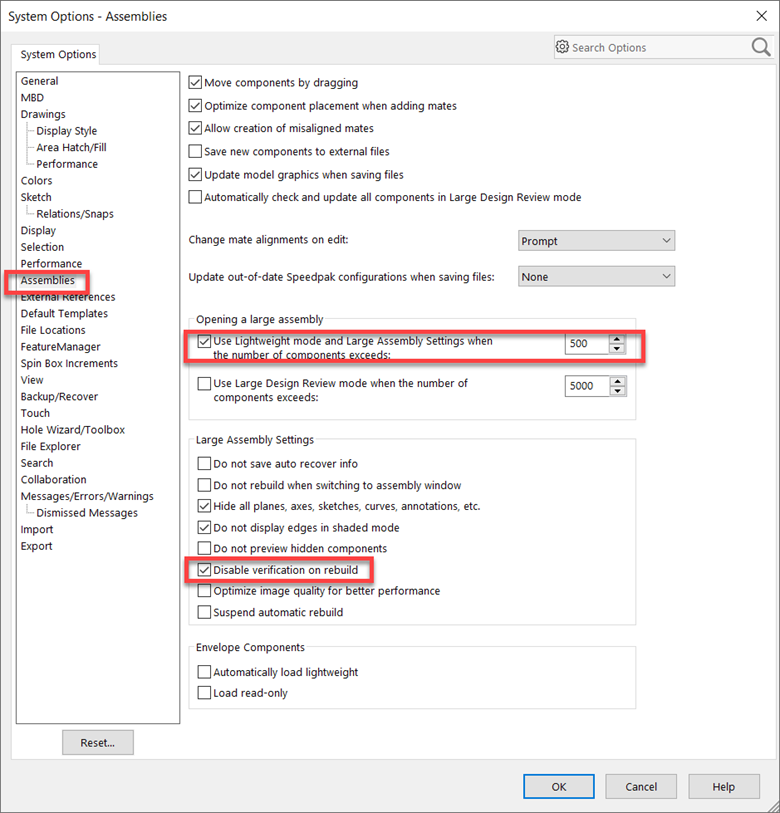
The top two settings in the External References group of settings could be extremely useful for specific case studies. Unfortunately, when both are checked, the results are disastrous.
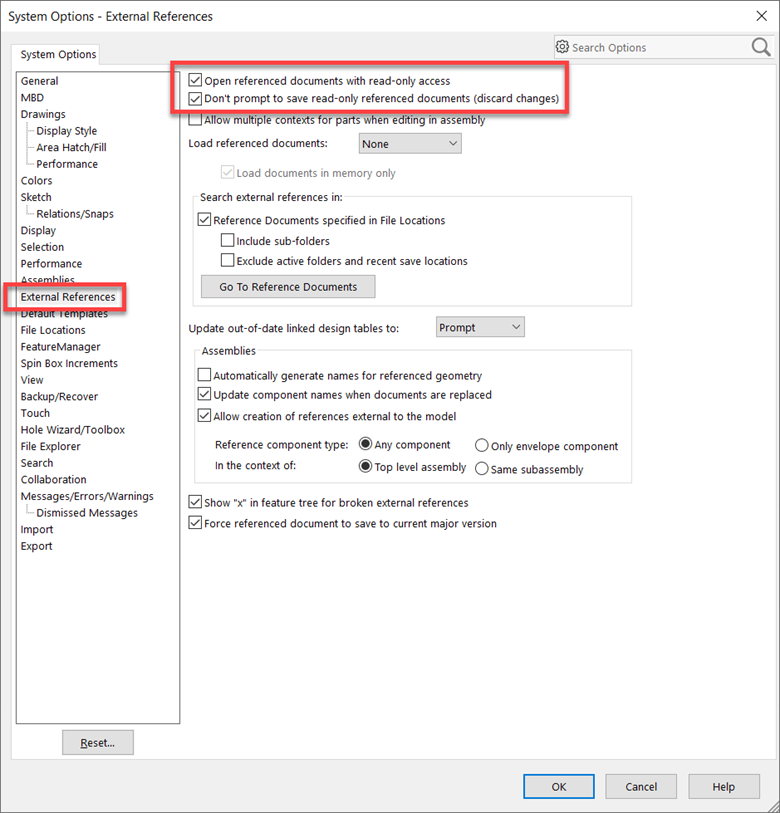
Figure 21. Do not do that!
To demonstrate how dangerous this combination of settings could be, let’s consider this case:
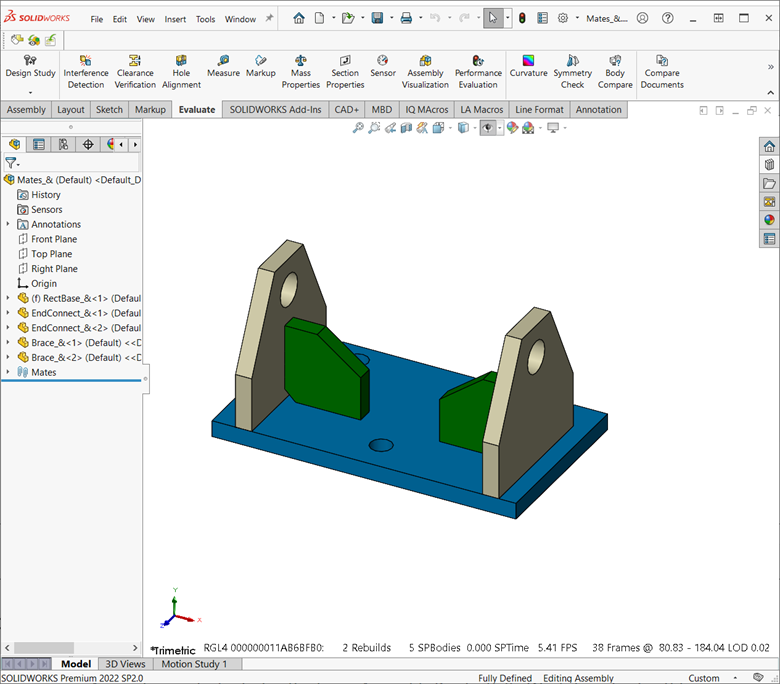
If you had not dismissed the error message shown in Figure 23, you might have a chance of noticing the problem. In practice, many users dismiss such messages.
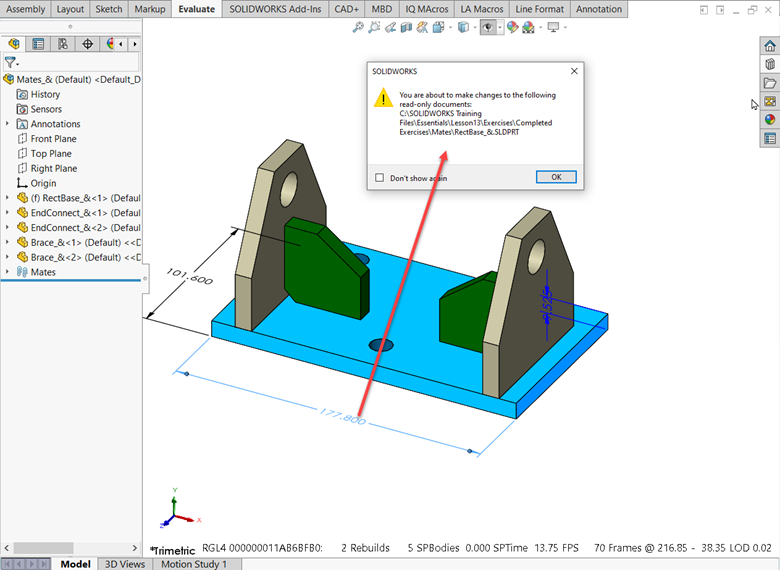
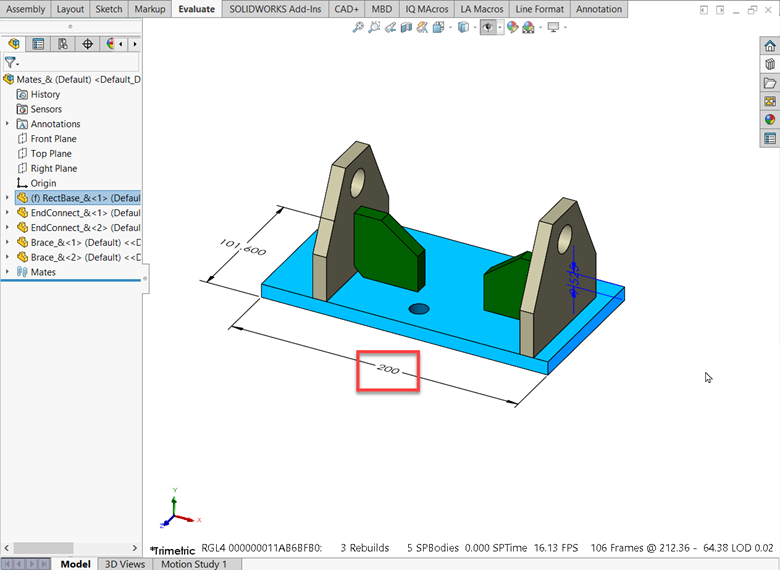
Notice that only the assembly file is listed in the list of models that will be saved.
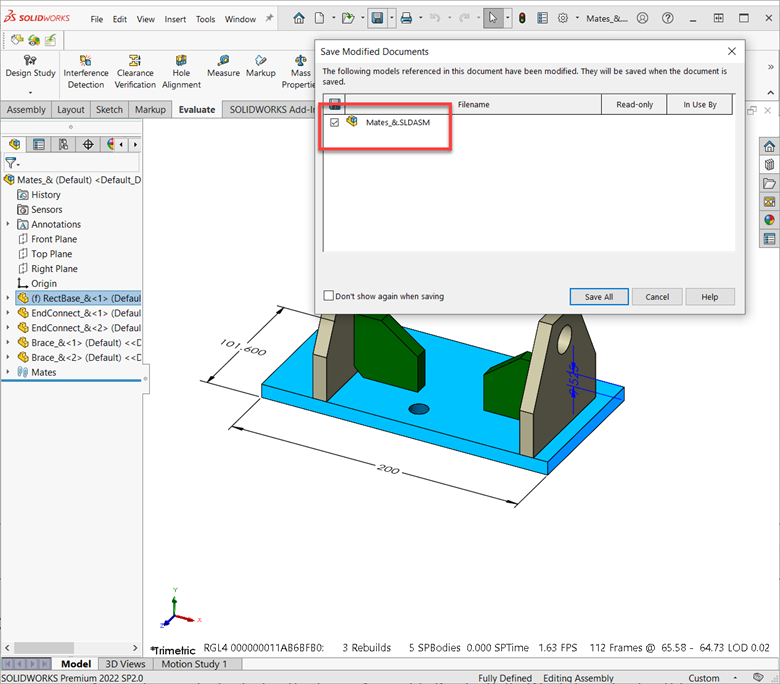
Notice that none of the modifications we performed at the part level have been saved.
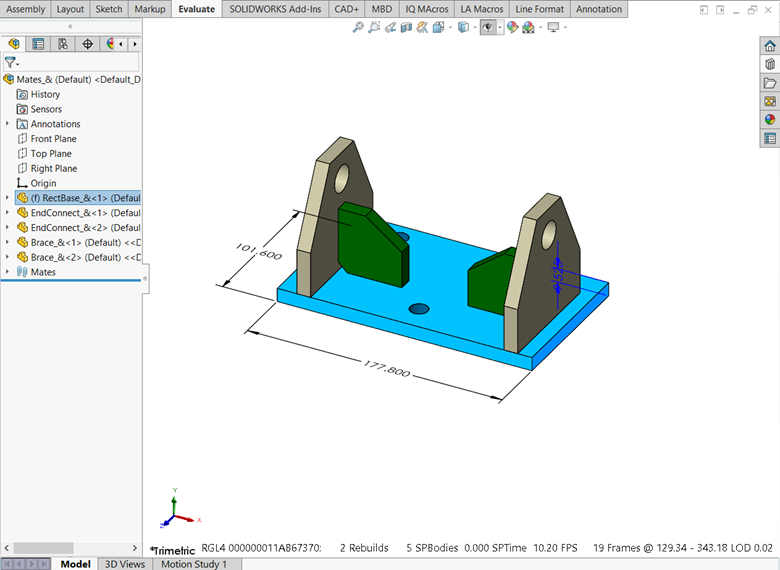
Users have been known to lose several days of work in the assembly environment because of these two settings. While each of them is useful in specific use cases, together they spell disaster.
About 10 years ago, during the Top 10 Ideas season, users with an AutoCAD background started a campaign for implementing a Purge function in SOLIDWORKS.
They argued that AutoCAD had a fantastic purge function that would quickly remove unused data and drastically reduce the file size. They thought SOLIDWORKS files were bloated and could use such a function.
There is a reason behind having a larger file in any CAD software, including AutoCAD and SOLIDWORKS. When computing a certain data set is time consuming, it might be more efficient to save that data in the file for future reuse. Avoiding computing unchanged data over and over could save users a lot of time.
Purging simpler AutoCAD 2D data might not have a huge impact on performance, since such data could be recomputed relatively fast. The situation is different for many SOLIDWORKS cases.
When developers considered what type of data could be safely “purged” from a SOLIDWORKS part or assembly file, they came up with configuration data.
Configurations in SOLIDWORKS could save the following type of data in the part or assembly file:
| Data Types | Active configuration | Inactive configuration | Active configuration | Inactive configuration |
| Features | Always | Always | Always | Always |
| Body Data | Always | Optional | Always | Optional |
| Mates Data | N/A | N/A | Always | Always |
| Custom Properties | Always | Always | Always | Always |
| Graphics Data | Always | Optional | Always | Optional |
When thinking about configuration data, we can make an analogy between baking a cake and building a SOLIDWORKS model.
When baking a cake, you follow a recipe. Features, mates and custom properties are part of the SOLIDWORKS recipe. They must be saved in the file.
To create a variation of that cake, simply modify the recipe. The look and the taste will be different. A recipe is pure information, usually written on a piece of paper. It cannot be eaten.
To produce the actual cake, you need to bake it according to the recipe. It is the same thing with SOLIDWORKS: to generate the body data you have to build the model feature by feature. Moreover, to generate the graphics data you must tessellate the body data in tiny triangles and hand it over to the video card to display.
Body data and graphics data take a lot of space, so purging them may have sounded like a good idea. It is true that usually computing the graphics is fast. After all, it is always done when the file is loaded, so no big loss here (other than the inactive configurations would not be accessible in eDrawings or the Large Design Review mode).
At the first sight, even computing the body data is usually pretty fast at part level. Assemblies and drawings, however, are a different story.
When the body data for a component of the assembly is missing (think of a small bolt that the assembly requires in one of its inactive configurations), the part needs to be rebuilt during the loading phase of the assembly. After rebuilding, it is identified by the assembly as a changed component. That triggers the rebuilding of all subassemblies containing it all the way to the top level, thus drastically increasing the opening time.
As you can imagine, the slow down is even worse for the drawing of the assembly. Since the assembly is identified as modified all drawing views will require updating. Depending on the number and types of drawing views, this could be a painful experience.
When the assembly or drawing is saved, because this setting is checked, all inactive configurations will get their body data purged, so the unnecessary rebuilding will happen again the next time the files open.
The part file in Figure 27 has a rebuild time of 15.19 second.
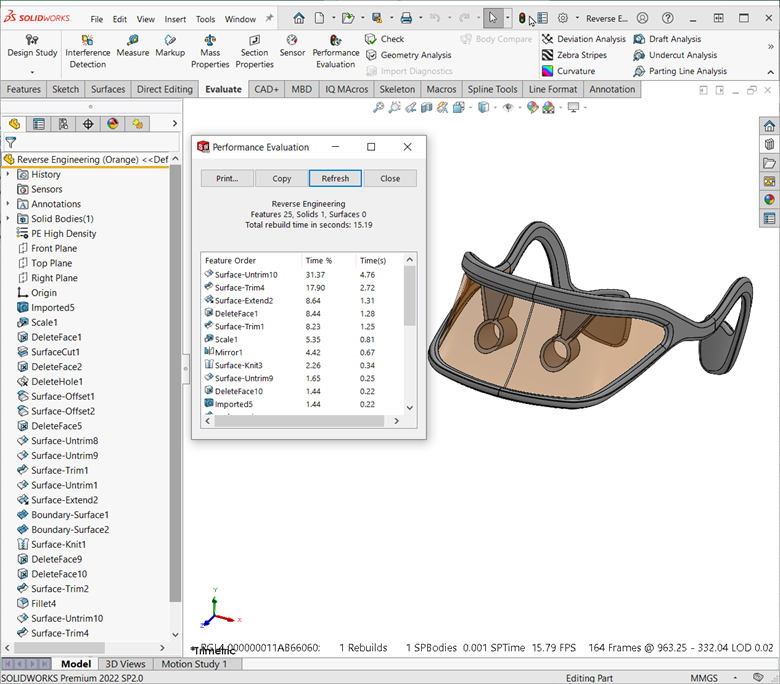
It has two configurations. As you could see in Figure 28, the inactive configuration does not have the body data computed.
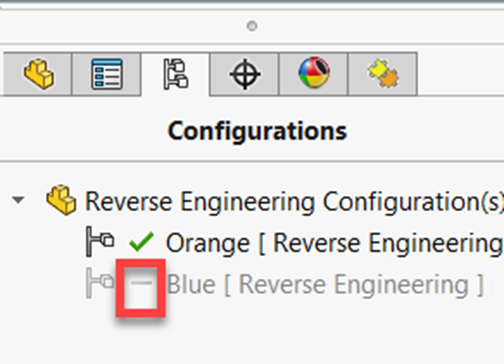
Opening an assembly calling for the Orange configuration takes 4 seconds. Opening an assembly that uses the Blue configuration takes 24 seconds, most of that taken by the rebuilding of the part, followed by the rebuilding of the assembly. That is six times slower.

When SOLIDWORKS 2013 was released, everyone praised Purging Configuration Data as an extraordinary enhancement. IT departments were thrilled because SOLDIWORKS files shrunk instantaneously and free space on the server grew.
It took a while for complaints about performance to start to trickle in. Users did not notice the performance hit right away, and it was gradual. The more files were saved, the more body data was lost, affecting mostly the library files.
After 10 years, there are still many technicians, instructors and presenters that recommend checking this setting without thinking of the implications on user performance when working with large assemblies and drawings.
The moral of this story: don’t allow anyone to check the “Purge cached configuration data” setting.
This is one of the settings that should be a document property and not a system option.
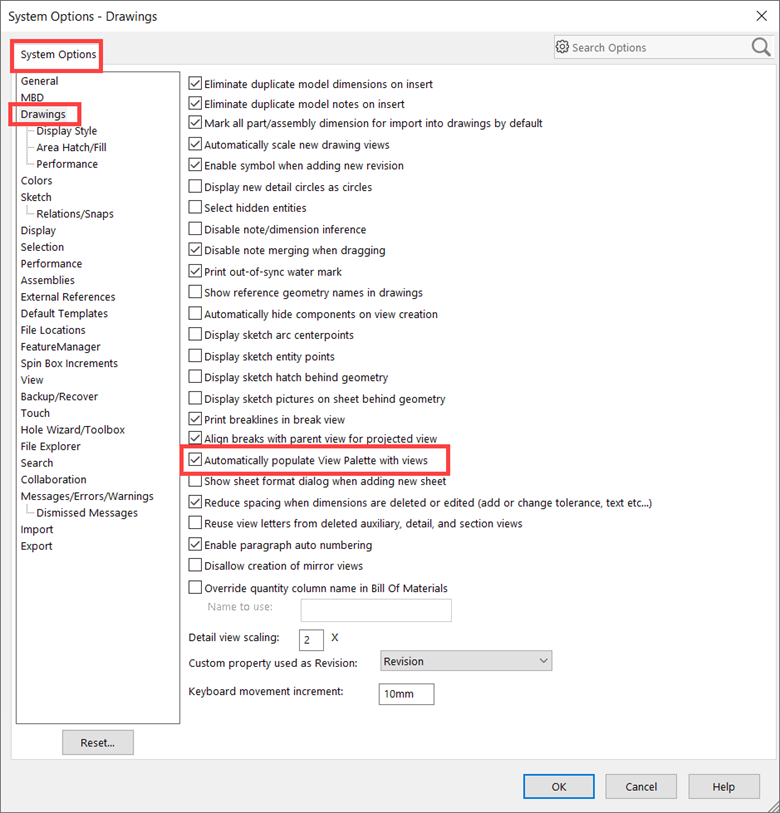
The View Palette is an amazing tool for speeding up the creation of drawing views. SOLIDWORKS pre-computes a set of drawing views based on the:
• Default orientation views:
• Current model orientation view.
• Saved orientation views.
• Saved section Views.
For example, for the model shown in Figure 31, the View Palette would automatically compute 17 views.
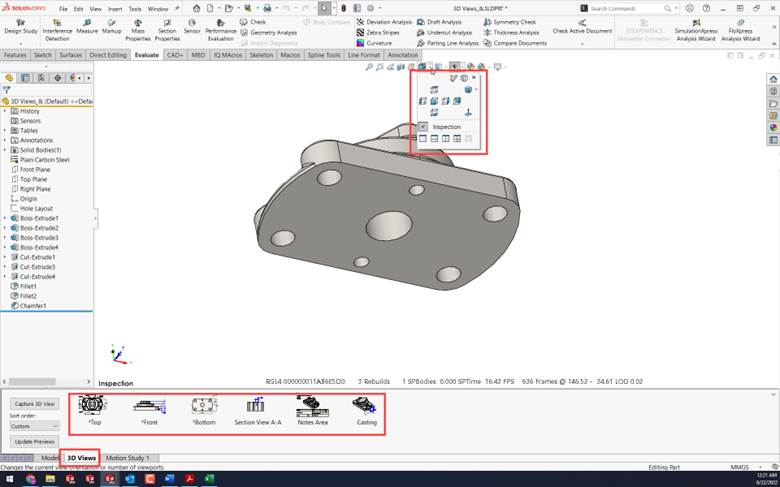
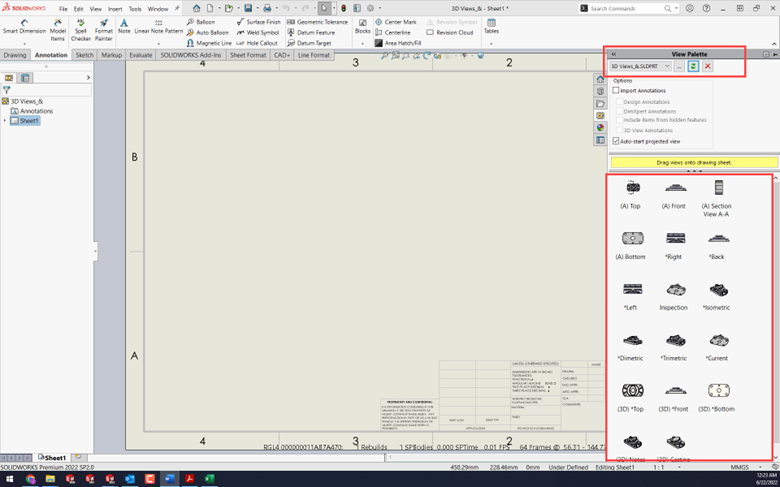
This is great for drawing of parts and small assemblies. For drawings of large assemblies, the amount of time spent computing and updating these views can be measured in minutes.
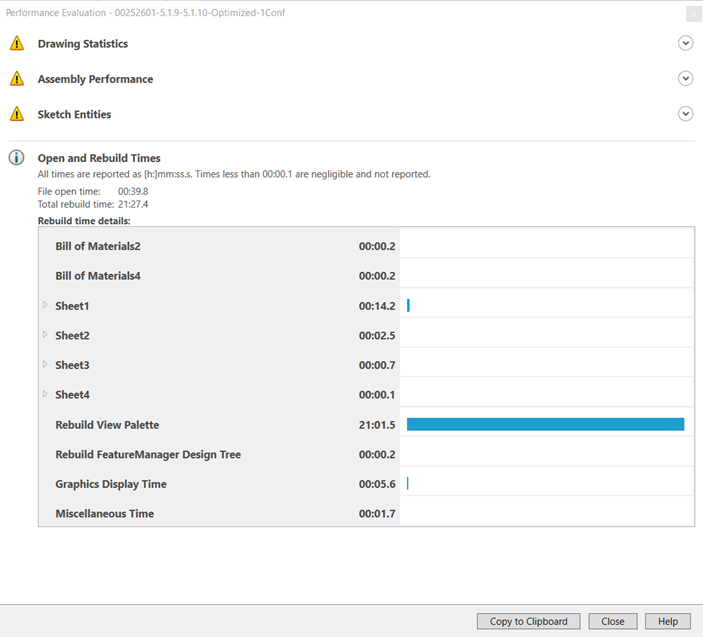
Figure 33. 21 minutes just to rebuild a set of potential drawing views that I no longer need?
This is a system option. When working with drawings of large assemblies you must remember to uncheck it. Hopefully, in a future version, this will become a document property, so you could deactivate it only for slow drawings.
This is one of those options that was introduced in SOLIDWORKS only for diagnostic purposes. When the graphics misbehave, you can check the setting to deactivate the hardware acceleration for the graphics and let the CPU do all the heavy work.
Notice that when a file is open, the option is greyed out and unselectable. Should you want to check or uncheck it, you need to close all files first.
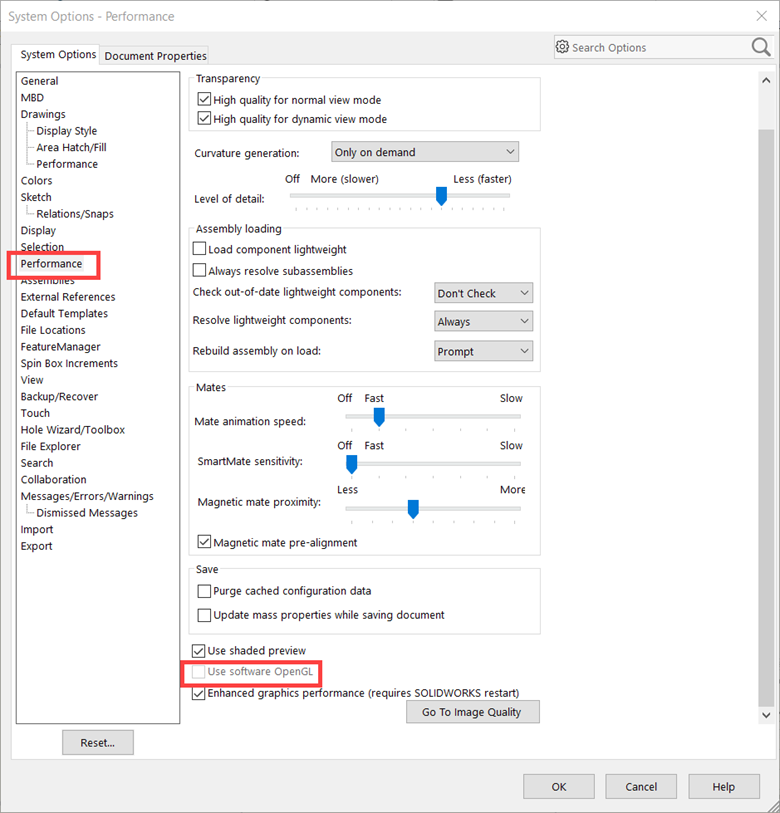
This option should never be checked in production by users. The response of the graphics would be horrendous, especially when working with complex parts or assemblies. You will encounter pronounced lag when spinning, panning or zooming the viewport. Also, any other operations like selecting or highlighting entities would have a visible lag.
Before SOLIDWORKS 2019, the graphics engine was based on OpenGL 2.0. When manipulating the viewport (zoom, rotate, pan, select) the work was shared by the CPU and the GPU (video card). This engine was old and slow and was not optimized to take full advantage of the power of modern video cards. There was almost no difference in performance between an entry-level graphics card or high-level one.
Starting with SOLIDWORKS 2019, a new graphics engine based on OpenGL 4.5 was offered as an option, using much more the GPU power.
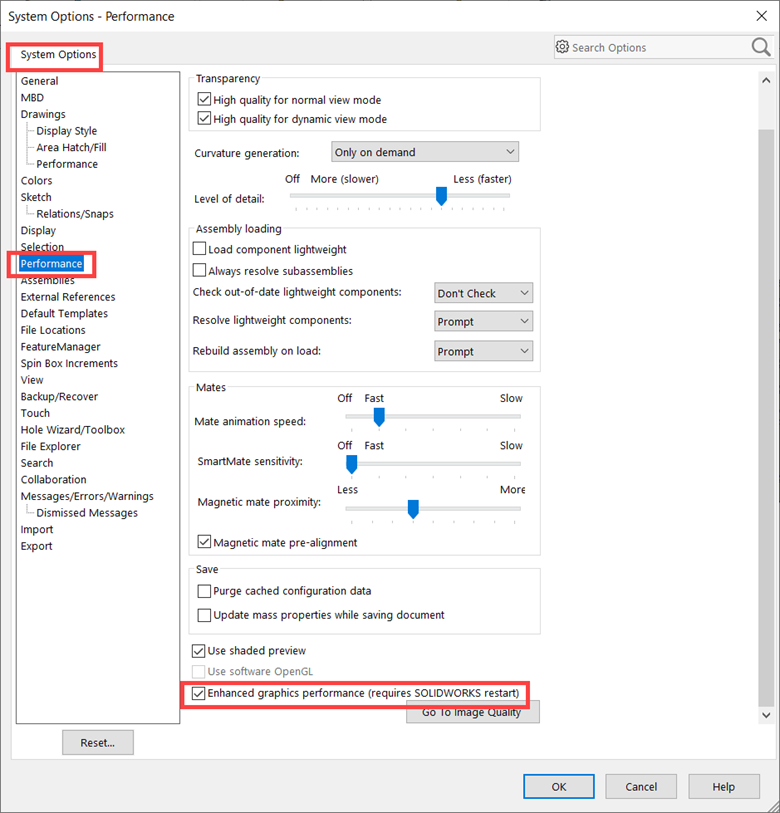
SOLIDWORKS 2019 and 2020 had this implemented only for parts and assemblies. Starting with the 2021 version, the graphics performance for drawings is also enhanced.
With this setting checked, the performance scales predictably with the quality of the video card. Even for midrange professional video cards, the rate of frame per second increased to above the human eye perception when spinning, zooming or panning large assemblies or drawings.
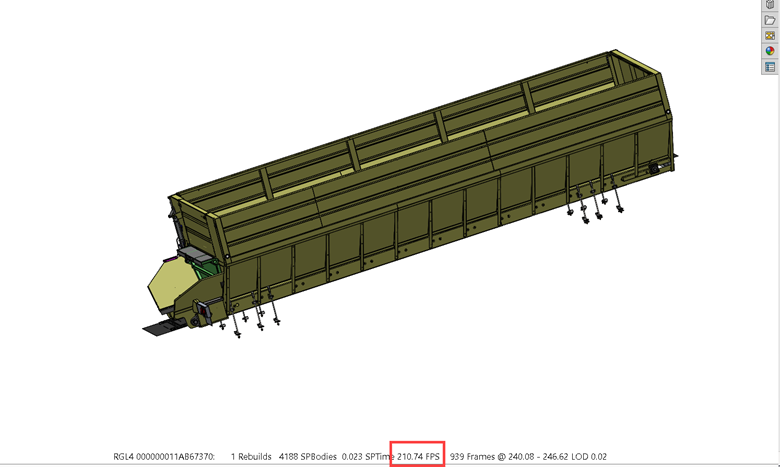
Figure 36. Who can perceive a rate of 274 frames per second?
Moreover, with this option checked, there is no need to “dumb-down” the graphics during dynamic manipulations. It is actually better to maintain maximum level of detail throughout the operations to eliminate the computations required for creating blocky views before spinning or zooming starts, and then reverting to the full detail when manipulating the viewport stops. Ideally, you should have the settings shown in Figure 37.
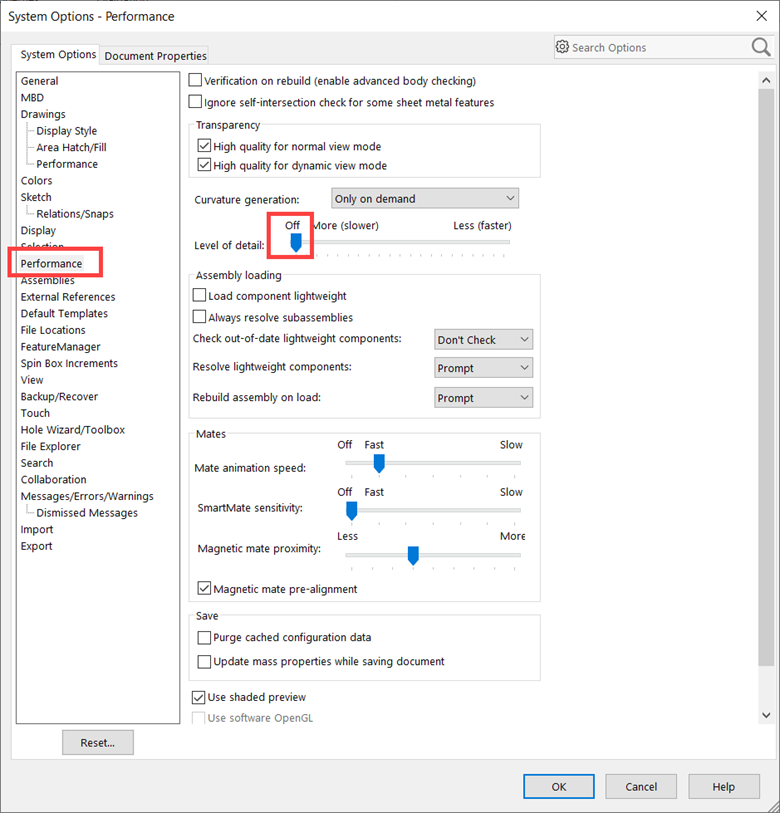
Be aware that if you have one of the latest NVIDIA video cards, in order to enable this functionality fully, you would have to download and install a software patch corresponding to the version of the software you are using.
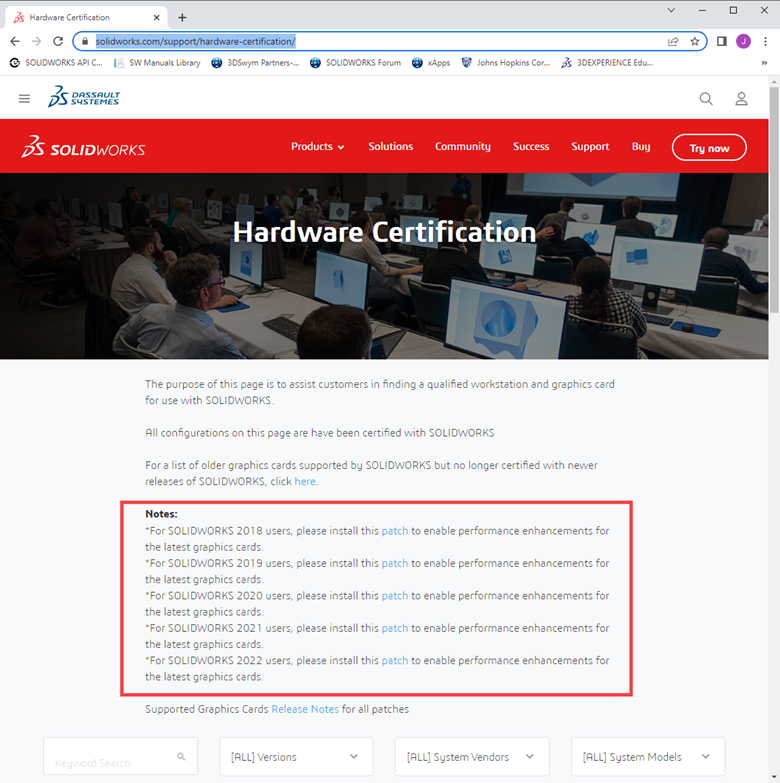
As usual with any new technology, there are growing pains. The stability of the new graphics engine improved with every release and every service pack but there are still bugs that could affect specific operations.
Some users report that sometimes random components of the assembly change their display style from shaded to wireframe. The solution is a forced refresh (CTRL+Q).
Other known issues affecting older versions:
If you find that such problems are frustrating, you can deactivate the new graphics engine by deselecting this setting. You will have to restart SOLIDWORKS for the change to take effect.
This is one of the most important options impacting productivity and security when performing revisions of drawings.
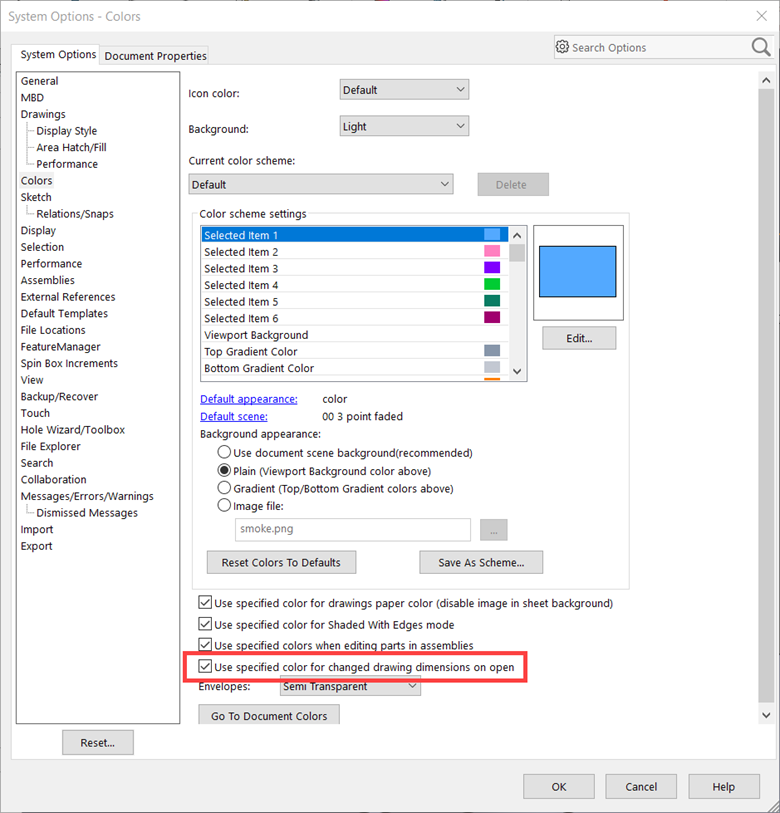
When this option is checked, any modified dimension will be temporarily shown in orange (default color) when a drawing opens.
In the model shown in Figure 40, we will change one dimension from 70mm to 90mm and rebuild the part.
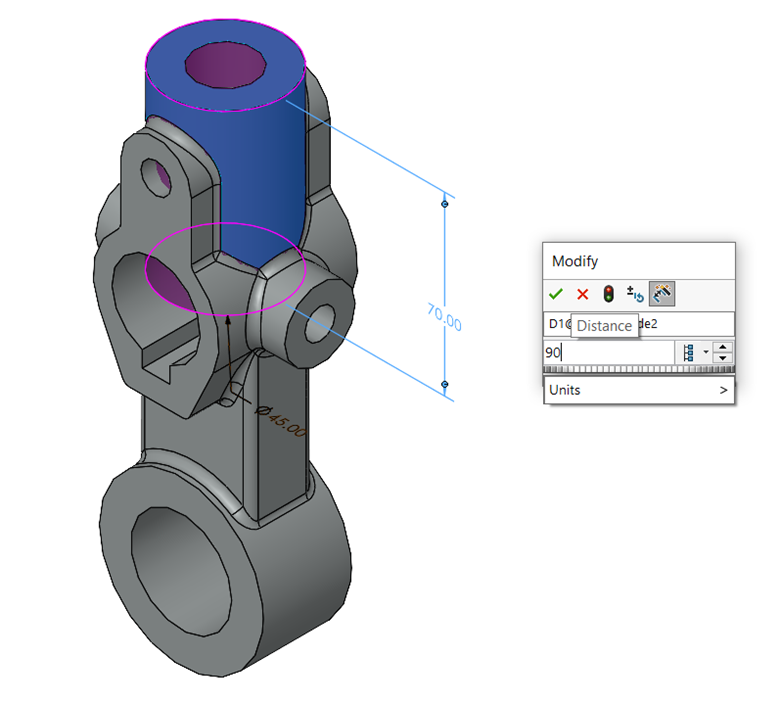
Upon opening and updating the drawing, any modified dimension is shown in orange. Notice that not only the 90mm dimension is highlighted, but also the 185 mm one. Is the second change correct? Maybe not, but at least we were warned.
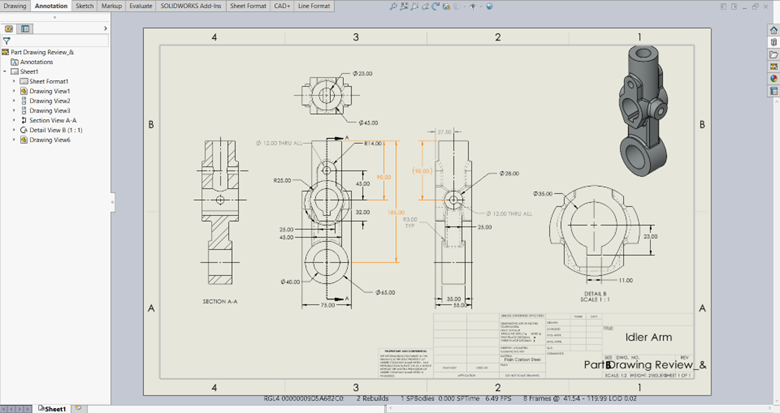
If you hover over the text of an orange dimension, the old dimension value is revealed.
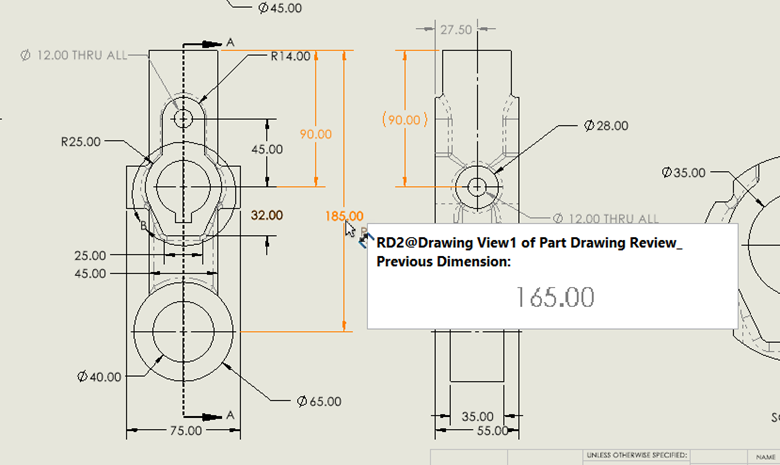
Unlocking this functionality will make capturing changes in dimensions during revisions an easy task. Moreover, it will highlight any other changes in drawing dimensions, including unintended consequences of the model changes.
Having the ability to quickly see in the FeatureManager tree the feature or component item corresponding to the item you selected in the graphics area is very valuable.
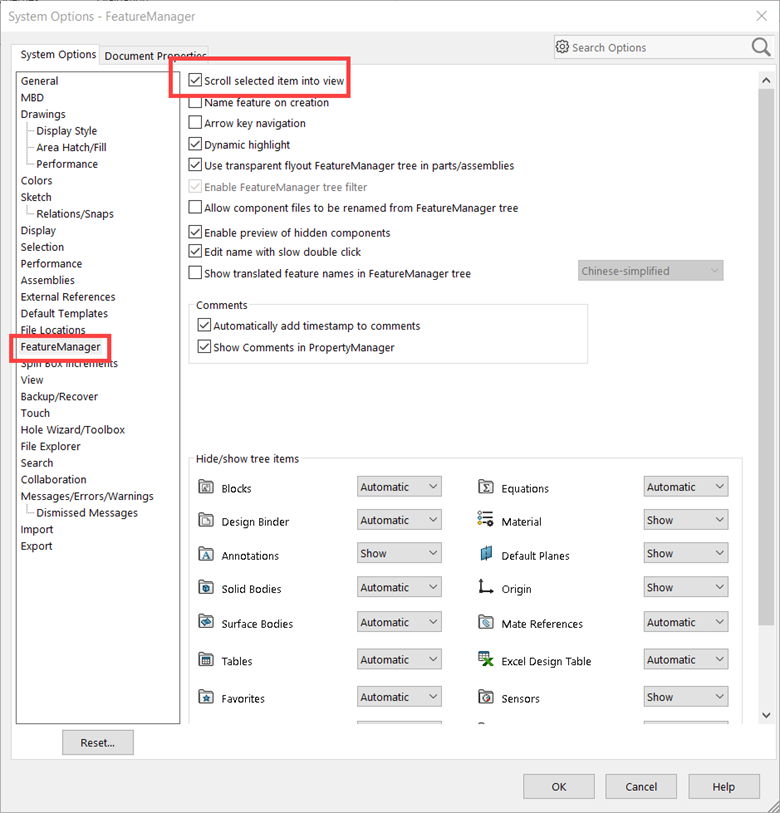
Unfortunately, when working with large assemblies, waiting for the item to scroll into view in the FeatureManager tree will be time consuming. Even worse, if you have SOLIDWORKS 2020 or older, attempting to isolate several components from an assembly opened in Large Design Review mode would trigger a lag that could last hours as SOLIDWORKS tries to bring each selected component into view one at a time).
The solution is checking and unchecking this setting as needed. While this operation is cumbersome, it could be easily sped-up by using a toggle macro, like the one presented at 3DEXPERIENCE World 2021.
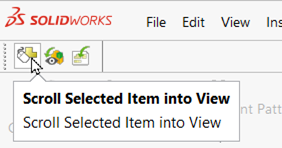
Figure 44. Scroll Selected Item into View OFF.
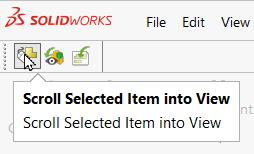
Figure 45. Scroll Selected Item into View ON.
You may be reluctant to send any type of data to someone else but this might help allay your concerns about the amount and type of information that is sent to SOLIDWORKS and how the transfer of data could impact performance and security.
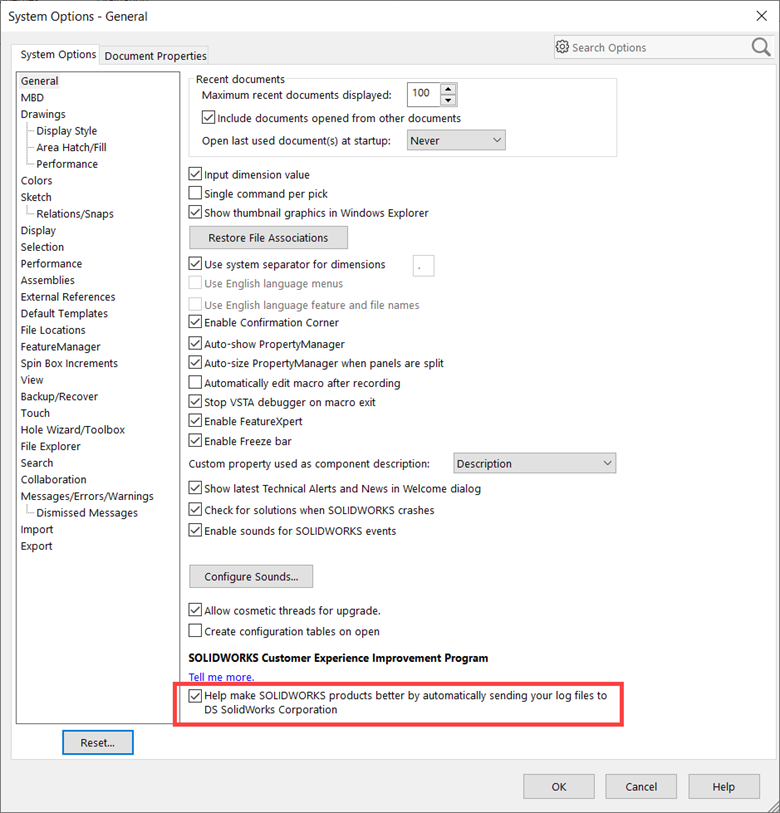
• As stated in the SOLIDWORKS Customer Experience Improvement Program, the type of data sent to SOLIDWORKS is limited to:
• The Customer Experience Improvement does not acquire information about you, your SOLIDWORKS designs or the usage of any other applications or activities.
Specifically, no model geometry, images or any other information that relates to the intellectual property of your designs that would enable the reconstruction of your design models.
No one will contact you unless you request it.
A good use case for this functionality is when multiple members of your team are experiencing unexplainable crashes. If all have this option checked, your VAR could ask SOLIDWORKS to comb through the logs sent by your users in order to find common causes triggering such events. Historically, this process solved many instability issues affecting multiple users.
This is an important setting affecting the security of data displayed when an assembly is opened in Large Design Review mode.
The Large Design Review mode is a very powerful tool for significantly improving the productivity of large assembly users. About 50 percent of the most common tasks performed on a large assembly can be done in this mode. Opening assemblies in seconds and starting working is very tempting but with great power comes great responsibility.
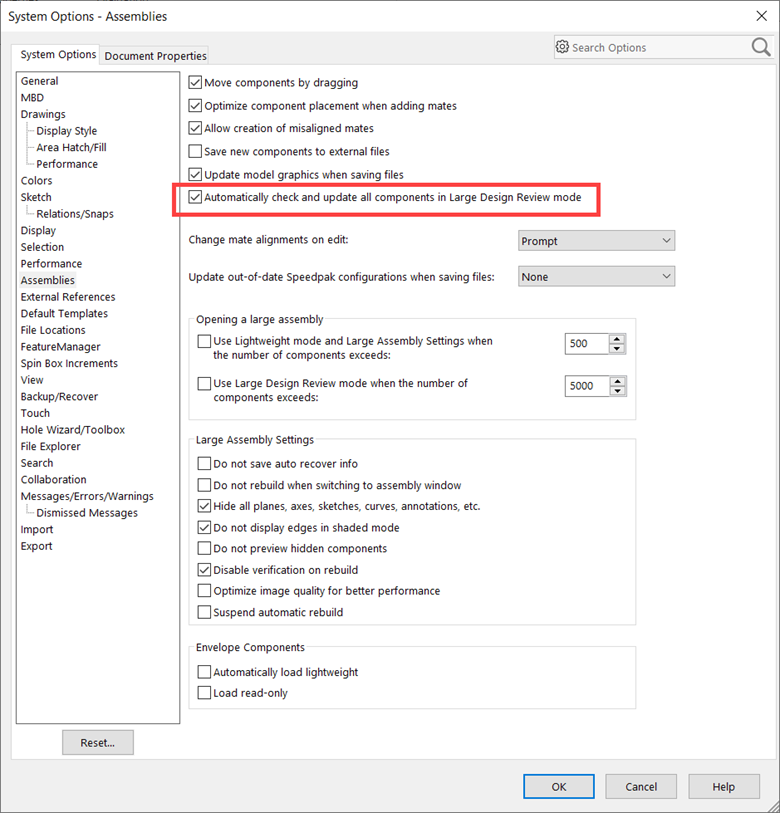
Opening assemblies so fast in this mode was made possible by using solely the graphics data saved in the assembly file. You could actually email someone else only the assembly file and they should be able to open it and access a lot of information about the assembly and its components. Starting with SOLIDWORKS 2020, they could even modify your assembly and send the revised version back to you.
The potential problem relies in the validity of the data saved in the assembly file. If a component or more were modified after the assembly was last saved, those changes will not be displayed in this mode since they were not captured in the current assembly file.
For users who have not received professional training in the use of the Large Design Review mode, it is imperative that this setting is checked. This way, when the assembly opens, SOLIDWORKS will dedicate a secondary CPU core to check and update the graphics data for all components. That is usually performed fast if the component files are on your local drive.
Also, considering that the checking operation is performed by a secondary core, you can continue working with the assembly during this process.
This was one of the Top Ten List ideas voted a year ago. It was promptly implemented in SOLIDWORKS 2022.
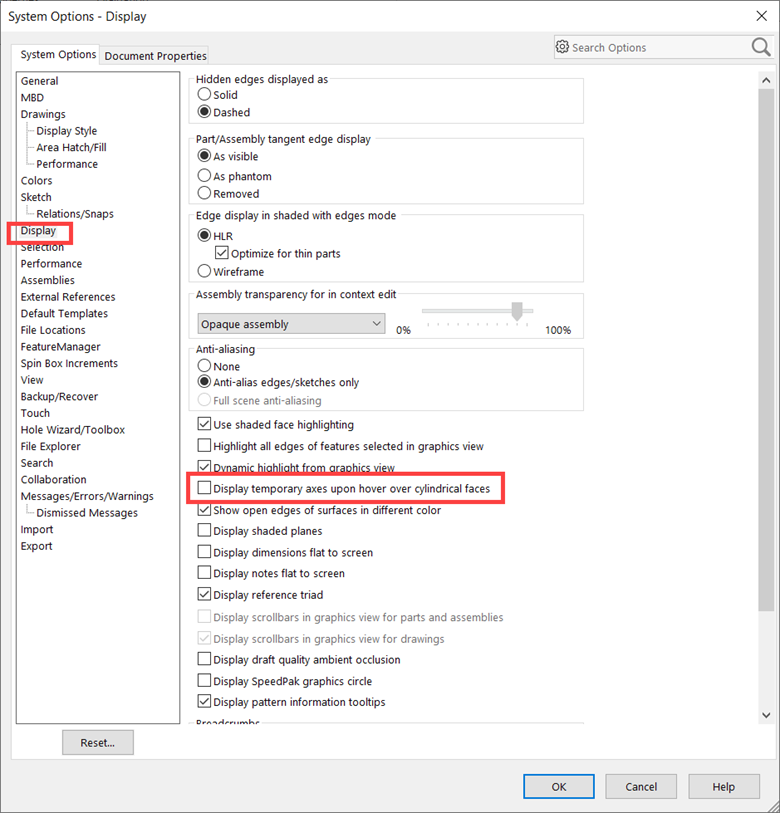
However, the initial implementation created all kind of problems:
Users raised these issues on the SOLIDWORKS forum and the Product Definition team reacted fast by including this new setting in SOLIDWORKS 2022 SP 2.0.
A temporary axis is a child of a face, so using it in mates would be counterproductive. You might as well uncheck this option unless you have a specific use case where it would be beneficial.
Breadcrumbs are the best thing added to SOLIDWORKS since… sliced bread.
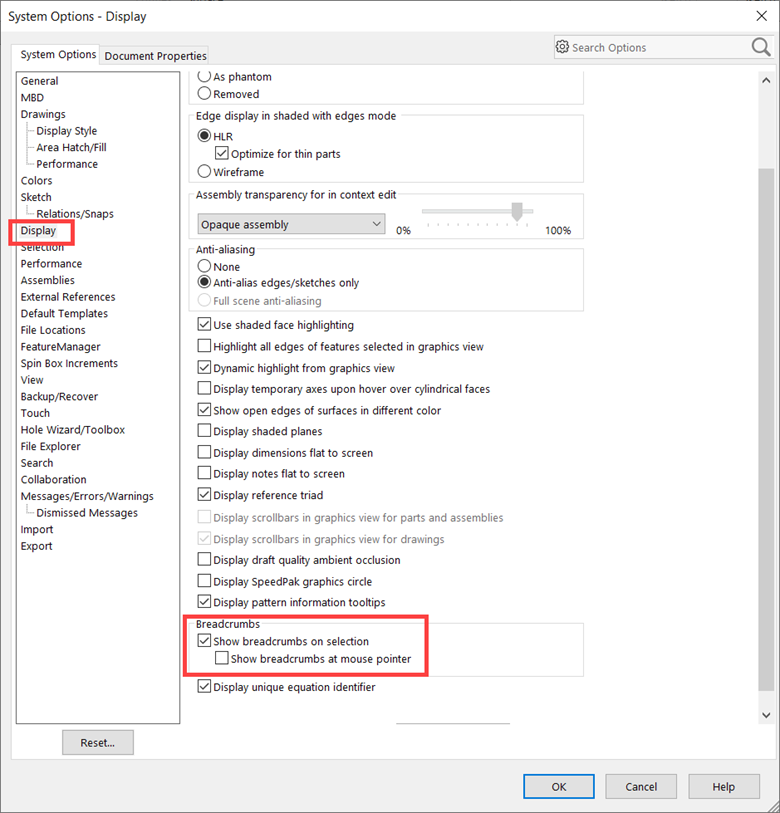
They free the user from the tyranny of the FeatureManager tree. When selecting a face, the user can access any entity related to that face directly in the graphics area. The context toolbar and right-mouse-button menu work like a charm with each selection level.

Figure 50. Initial selection of a face.
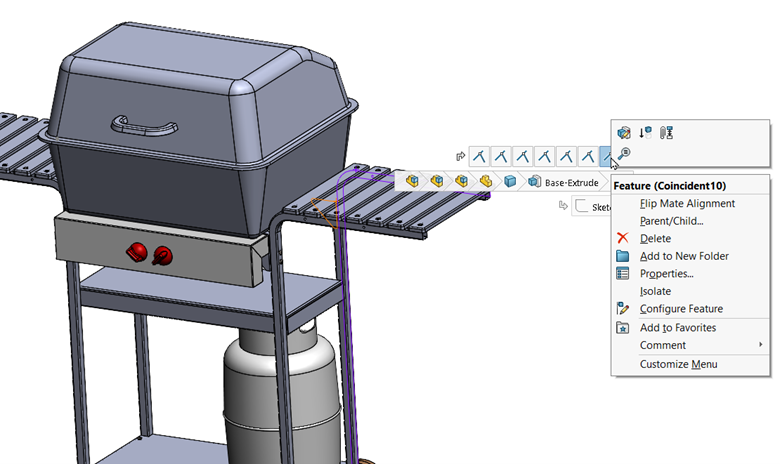
Figure 51. Accessing the mates of the first level subassembly.
While it might be tempting to also check the “Show breadcrumbs at mouse pointer” box, we recommend using instead the “D” keyboard shortcut for bringing breadcrumbs near the cursor.
The automatic behavior triggered by the second checkbox pushes the context toolbar away from the cursor and unnecessarily complicates the graphics area.
This is one of the most useful settings in SOLIDWORKS and is, at the same time, the most unchecked option in the user community.
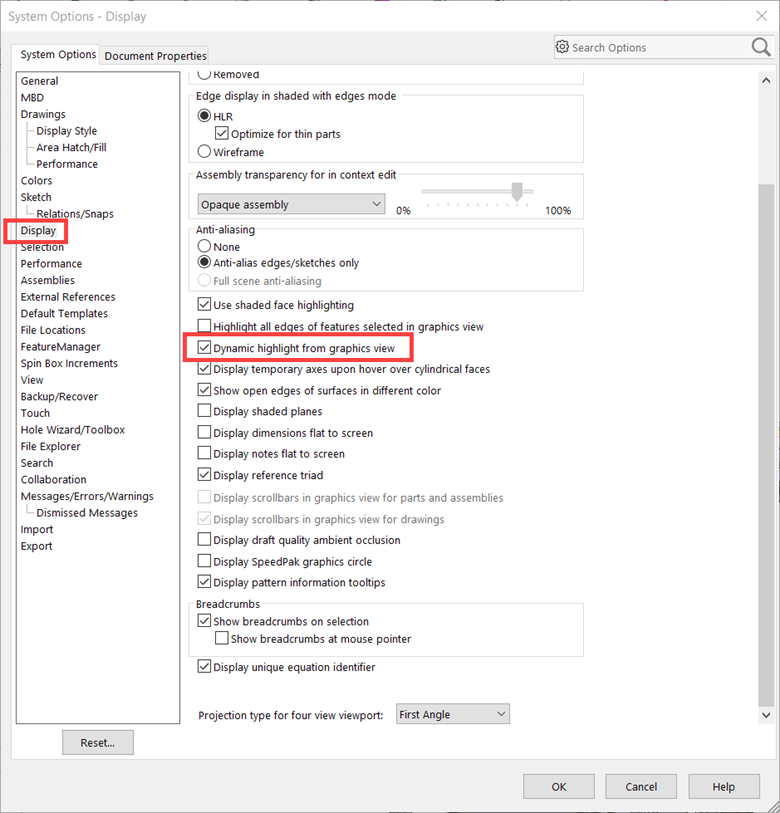
When checked, the user gets instant confirmation about which entity will be selected by simply hovering over it. This is very useful when selecting entities that are close to each other or otherwise hard to select.
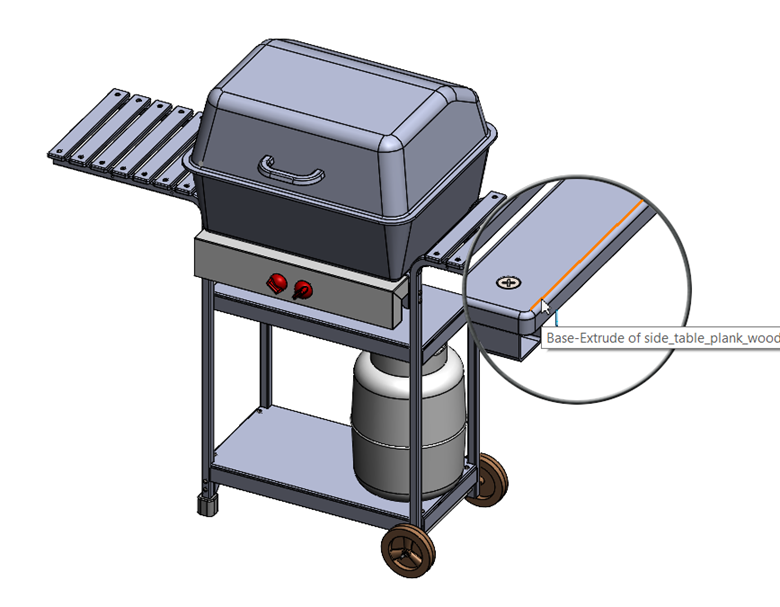
Figure 53. I wanted to select that edge. By painting it orange, SOLIDWORKS confirmed that my selection will work as intended.
The Recent Documents portal is a fantastic time saver when working with a set of files and folders for a long time.
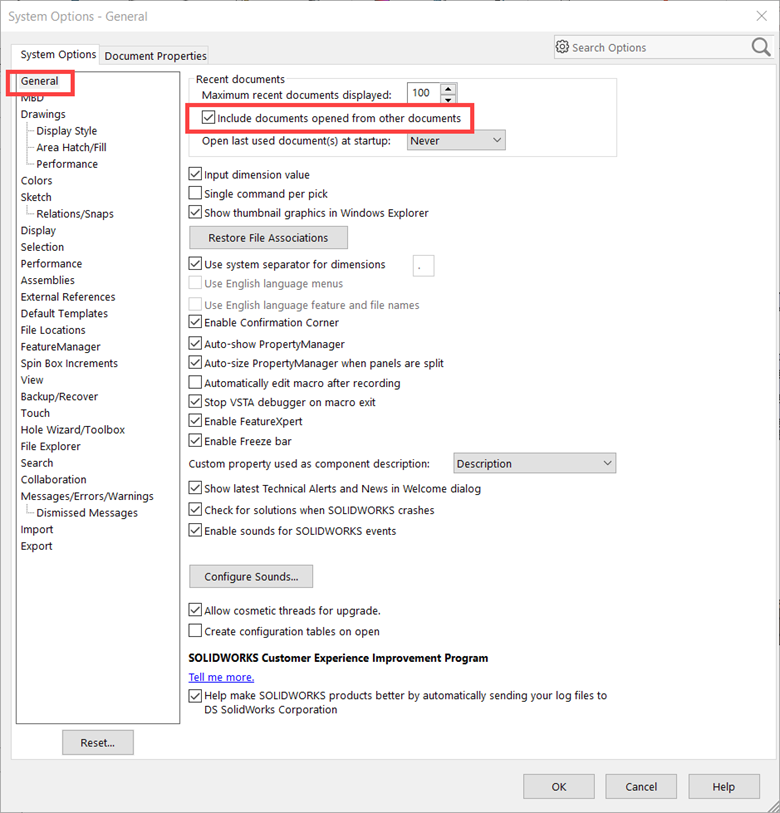
By pressing “R” you can access up to 100 recently opened files. Hovering over any of the thumbnails will provide a wealth of information.
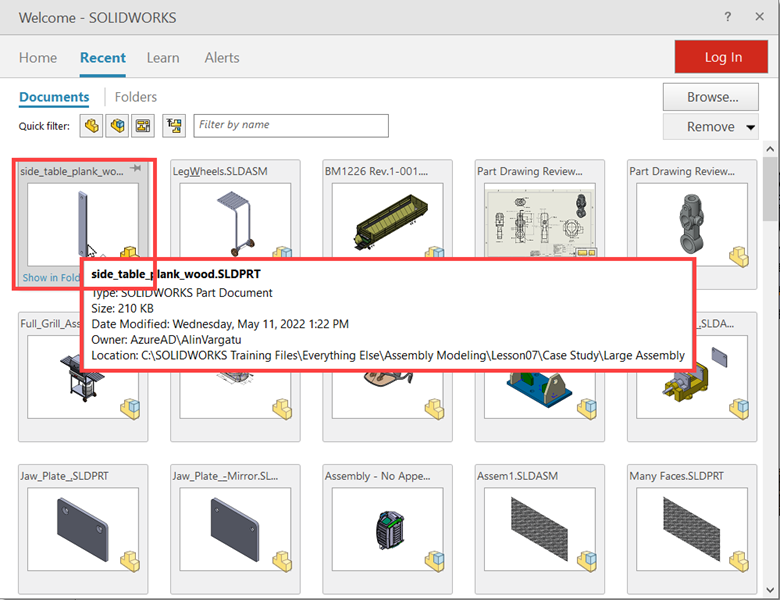
As you experiment with this functionality, attempt to pin and unpin a file, try the Show in Folder command or click on the double arrow on the bottom right of a thumbnail.
What about components that you open directly from an assembly containing them? If you need to see them added to this portal, check the option listed in Figure 54.
While this setting is available as a system option only in SOLIDWORKS 2020 and 2021, its state could have a critical impact on:
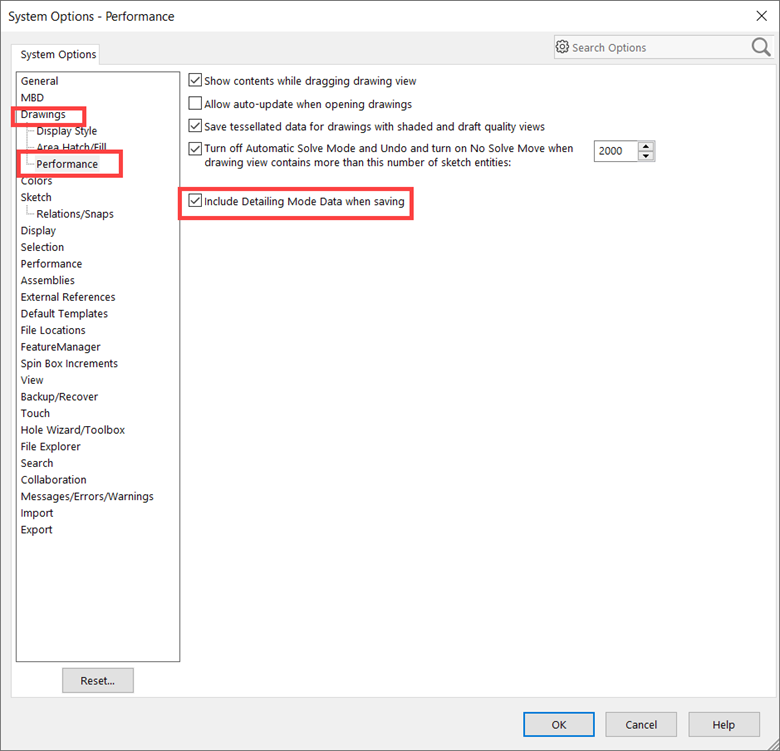
As we wrote in the Fast Drawings of Slow Assemblies article, the detailing mode revolutionized working with large drawings by allowing the drawings to open without their models in memory.
“Unfortunately, with improved functionality, more data needed to be written in the drawing file. If the drawing data was not optimized for this use, the saving operation took much longer than expected (hours versus seconds),” says Mark Johnson, the SOLIDWORKS User Success Engineering Director.
“The way Detailing mode works is every edge is assigned a unique silhouette edgeID by SOLIDWORKS behind the scenes. High Quality Hidden Lines Removed (HLR) drawing views already have these edge IDs, so drawings save performance for HLR drawings is the same in 2020/2021 and older versions.”
“These unique silhouette edgeIDs are not present for Shaded or Shaded with Edges. As a result, upon save, these edgeIDs must be generated and assigned to all shaded with edges views across all sheets.”
“The result is the potential for a much slower save of an SLDDRW in 2020/2021 vs 2019 and older.”
In summary, if a drawing view could not be set as a high-quality view, the information related to model edges could not be efficiently written in the drawing file. That makes sense considering that in draft quality views, the edges are computed based on the graphics-triangles extracted by tessellating the mathematical body data of the model. Imagine the sheer number of tiny triangles edges that must be stored for each single edge.
It is worth noting that if your drawings illustrate components with imported geometry errors, the drawing views will always be draft quality and the saving operation will suffer.
The problem was discovered very late and SOLIDWORKS R&D came up with a drastic solution: a System Setting that would enable users to decide if the data required for the Detailing mode will be saved or not saved in the drawing file.”
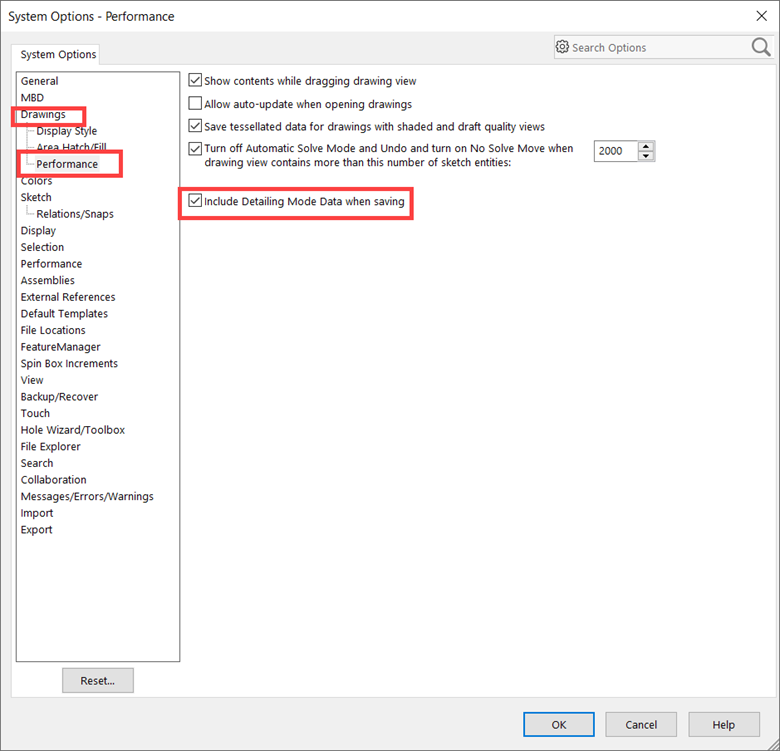
The solution was not ideal for many reasons:
SOLIDWORKS 2022 implemented a much better solution by moving this option to the document properties. This way, the users could have the Detailing mode data not saved for most of the drawings (small drawings would never use this functionality) and saved for large drawings.
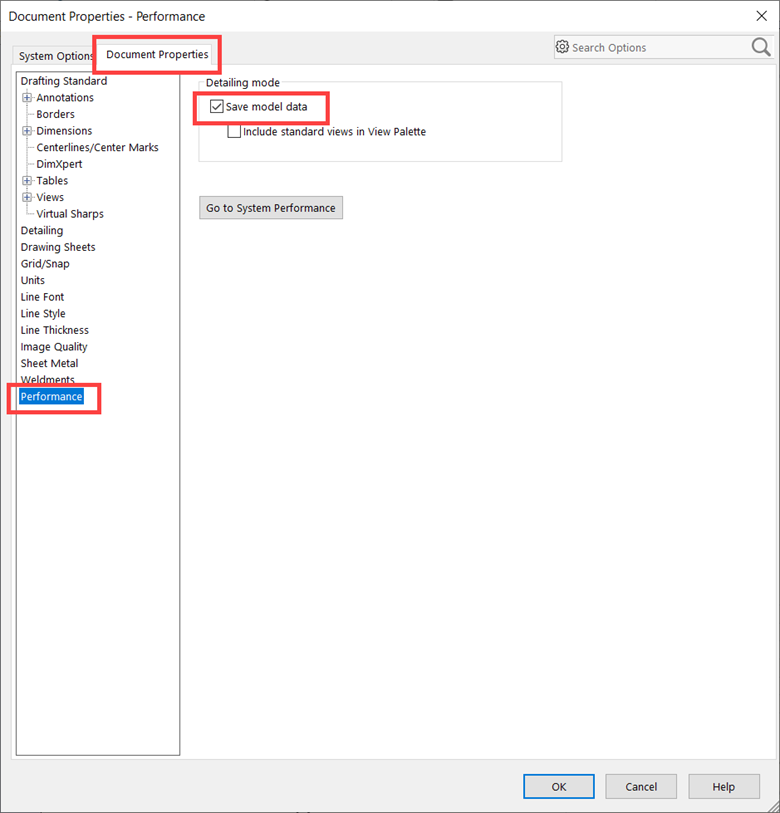
Some of the most frequent checks that a complex part designer performs when modeling is Deviation Analysis, Curvature Analysis or Zebra Stripes display to ensure that certain faces are tangent to each other.
Fortunately, by checking this option, the software will automatically provide visual feedback about tangencies in the model by displaying the edges shared by tangent faces in phantom font.
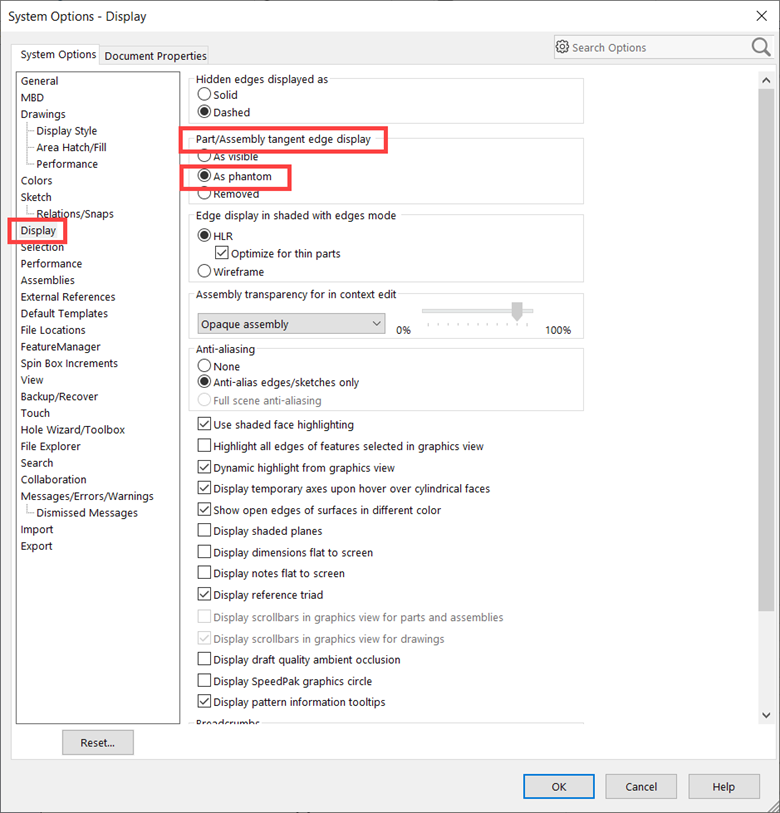
Instantly seeing the result of any edits is a great time saver.

Checking this option eliminates the danger of sketch entities jumping all over the place when the first dimension is applied.
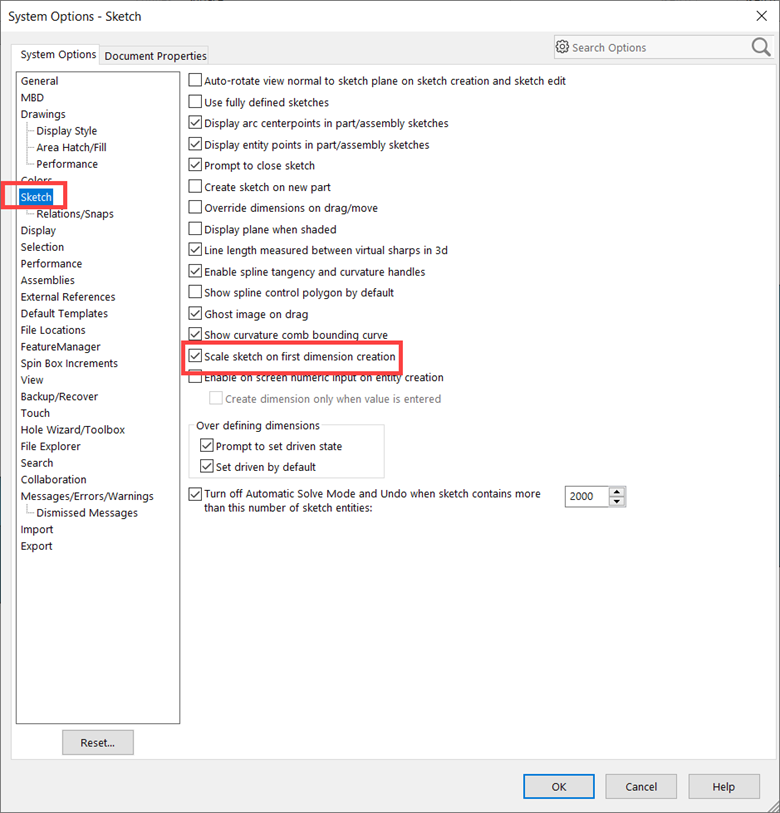
SOLIDWORKS simply scales all entities in the sketch with the ratio between the original length of the entity that is dimensioned and the dimension value. It is a thing of beauty.
Search is superbly implemented in SOLIDWORKS. When working with assemblies having thousands of components with many features and custom properties, searching for a specific entity can be time consuming. By unchecking this setting, users ensure they will not experience lag when typing the search criteria.
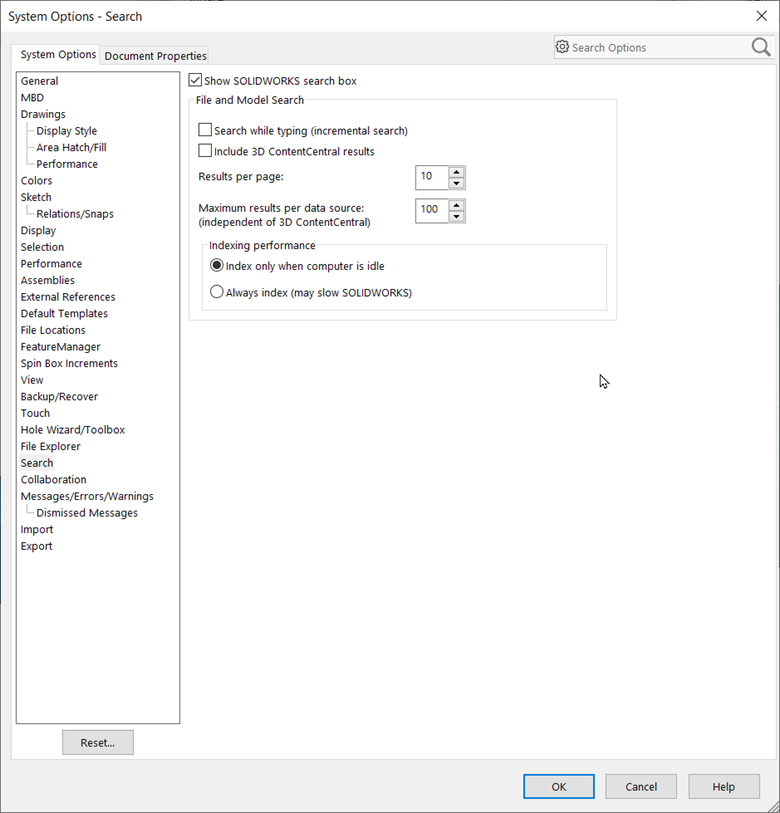
While this option should never be checked simultaneously with the “Open referenced documents with read-only access,” on its own it is a great time saver, especially for PDM users.
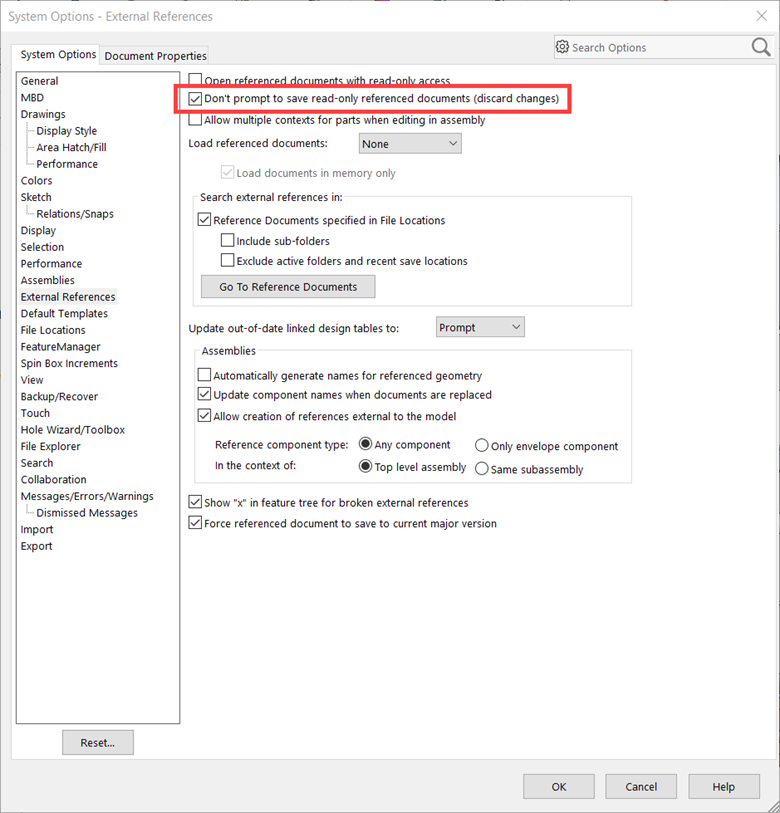
When working with large assemblies or drawings, small changes could trigger updates at the component level without actually changing their geometry. Moreover, for many users, such components are loaded from a read-only library, or they have not been checked out from a PDM vault.
If this option is not selected, the saving time will be increased significantly as SOLIDWORKS checks and displays the list with all perceived modified components. In reality, maybe only the main assembly and one or two subassemblies had to be saved, so ignoring the read-only files could greatly improve efficiency.
Have you read about the amazing new configuration tables enhancement introduced in SOLIDWORKS 2022 and could not find it in your models? Turning this option on will allow the creation of such tables on existing files.
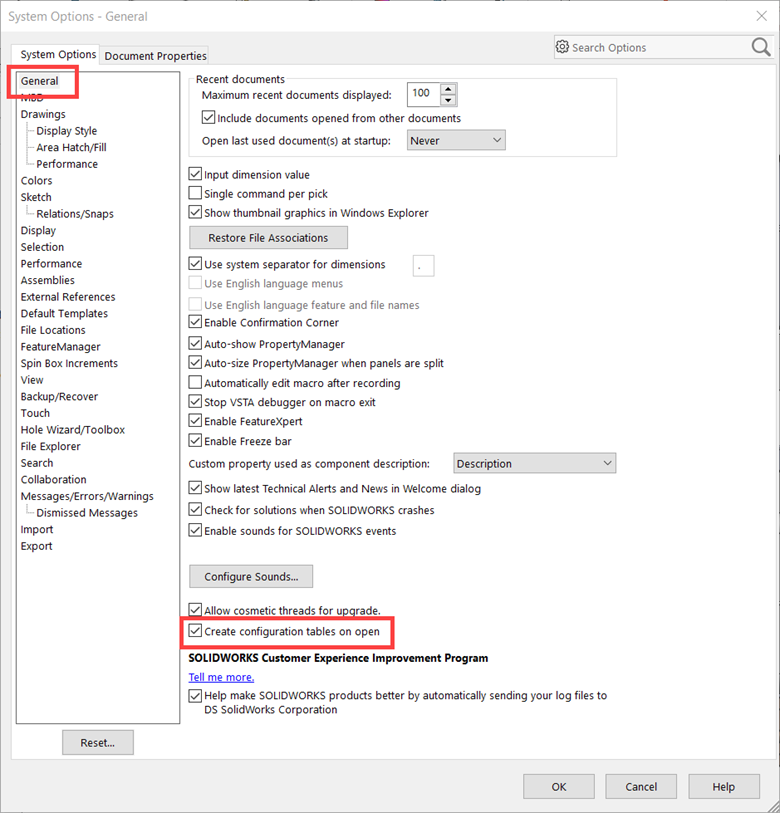
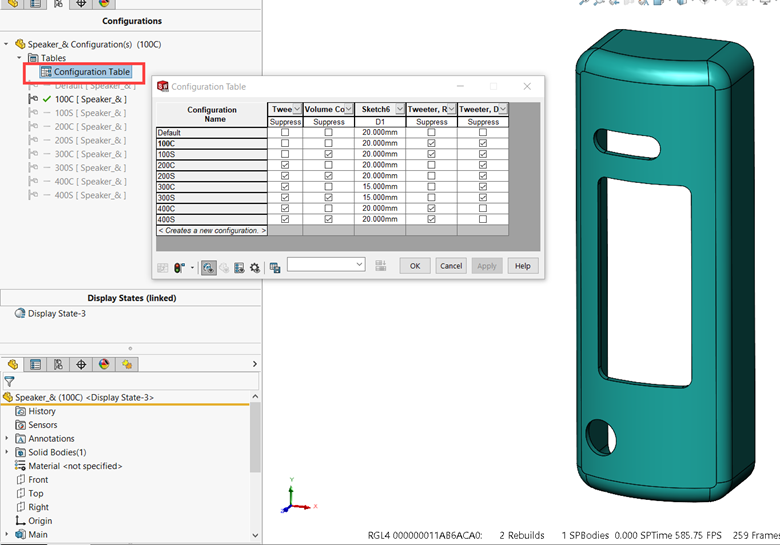
The System Settings are the foundation of SOLIDWORKS usage. An optimal set of settings positions any user to achieve maximum efficiency for their specific use cases.
This is even more important when considering team-level consistency. CAD admins could even lock certain system settings using Administrative Image Option Settings.
About the Author
As an Elite AE and Senior Training and Process Consultant, working for TriMech Solutions, Alin Vargatu is a Problem Hunter and Solver.
He has presented 33 times at 3DEXPERIENCE World and SOLIDWORKS World, twice at SLUGME and tens of times at SWUG meetings in Canada and the United States. His blog and YouTube channel are well known in the SOLIDWORKS Community. In recognition for his activity in the SOLIDWORKS Community, at 3DEXPERIENCE World 2021, the SWUGN (SOLIDWORKS User Group Network) awarded the SOLIDWORKS AE of the Year title to Alin Vargatu.